Inventors quantify My language (Mylang) documentation
Author: The Little Dream, Created: 2018-11-30 13:29:33, Updated: 2022-12-09 17:46:10[TOC]
My language is a programmed transaction language that is compatible with and enhanced by Ma. FMZ-quantized My language performs strict syntax checks, such as when using language enhancement embedded in JavaScript language code.%%An error is generated if the operator is followed by more than one space character.
-
Basic information
-
The Contract
The digital currency contract
The digital currency contract
this_week µĢ░ÕŁŚĶ┤¦ÕĖüµ£¤Ķ┤¦ÕĮōÕæ©ÕÉłń║” next_week µĢ░ÕŁŚĶ┤¦ÕĖüµ£¤Ķ┤¦µ¼ĪÕæ©ÕÉłń║” month µĢ░ÕŁŚĶ┤¦ÕĖüµ£¤Ķ┤¦µ£łÕ║”ÕÉłń║” quarter µĢ░ÕŁŚĶ┤¦ÕĖüµ£¤Ķ┤¦ÕŁŻÕ║”ÕÉłń║” next_quarter µĢ░ÕŁŚĶ┤¦ÕĖüµ£¤Ķ┤¦µ¼ĪÕŁŻÕ║”ÕÉłń║” third_quarter µĢ░ÕŁŚĶ┤¦ÕĖüµ£¤Ķ┤¦ń¼¼õĖēÕŁŻÕ║”ÕÉłń║” last_quarter µ£ĆÕÉÄÕŁŻÕ║”ÕÉłń║” XBTUSD BITMEXµ░Ėń╗ŁÕÉłń║” swap ķÖżBITMEXõ║żµśōµēĆõ╗źÕż¢µĢ░ÕŁŚĶ┤¦ÕĖüµ£¤Ķ┤¦µ░Ėń╗ŁÕÉłń║” ÕģĘõĮōÕÅ»õ╗źÕÅéń£ŗJavaScript/Python/C++µ¢ćµĪŻńÜäexchange.SetContractType()ÕćĮµĢ░ķā©Õłå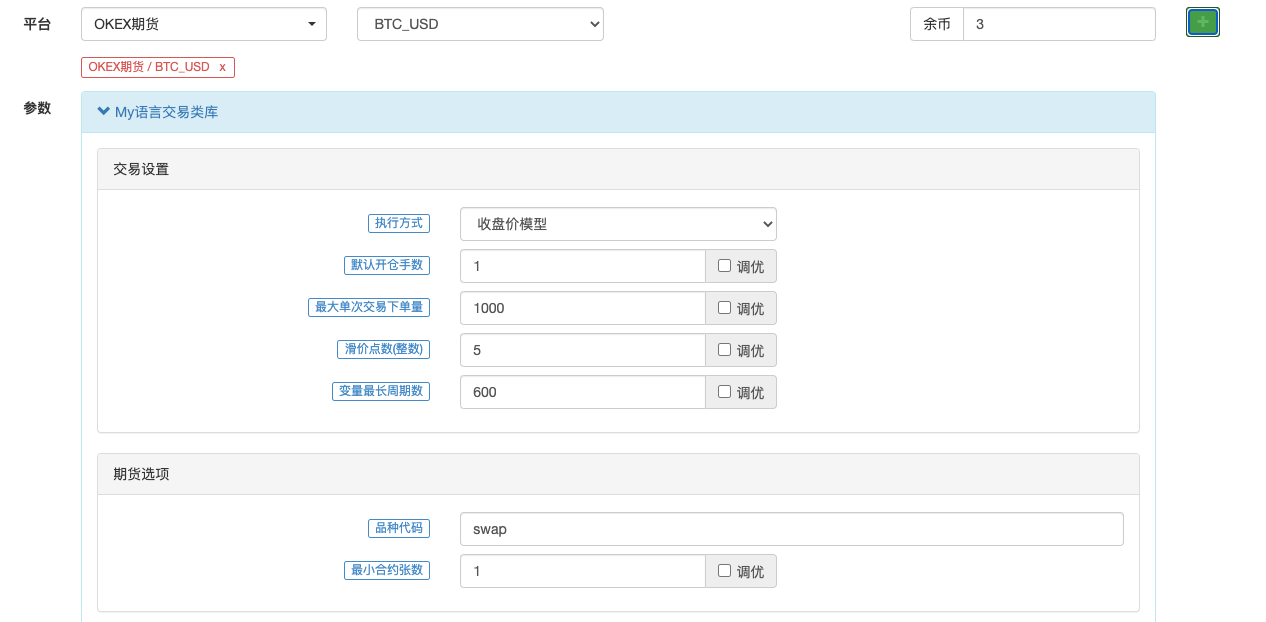
-
Variable
A variable is a piece of space in a computer's memory that is used to store data.
Open the first variable
// Õ░å1ĶĄŗÕĆ╝ń╗ÖÕÅśķćÅa a:=1;In the
ķ║”Ķ»ŁĶ©ĆIn and outµĢ░µŹ«ķćÅThis is a simple distinction:- Single-value data: only one value, for example
0ŃĆü1ŃĆüŌĆÖabcŌĆÖŃĆé - Sequential data: A data sequence consisting of a single-valued data set, e.g.
Close(Closing price), hereCloseIncludesnThe closing price of the cycle[ 10.1 , 10.2 , 10.3 , 10.4 , 10. 5 ...]
Distinguish from variable-type silicon
- String type: must be used
''Packages, string types are not allowed to be used directly, and function output to the view is required.
INFO(CLSOE>OPEN,'OK!');- Numerical types: Includes integers, floating point numbers (comma) ŌćÆ
// µĢ┤µĢ░ int:=2; // Õ░ŵĢ░ float:=3.1;- Boolean type, using 1 (to represent true) or 0 (to represent false):1, 0, true or false; for example:
A:=1>0;After the execution of the code, the user will be able to access the file.AThe value is 1Ōüä4.
// ÕĮōÕēŹÕ橵£¤µöČńøśõ╗ĘÕż¦õ║Ä-999’╝īõĮĀõ╝ÜÕÅæńÄ░’╝īµ»ÅõĖ¬Õ橵£¤ńÜäĶ┐öÕø×ÕĆ╝ķāĮµś»1’╝īõ╗ŻĶĪ©true’╝īÕøĀõĖ║µöČńøśõ╗ĘÕćĀõ╣ÄõĖŹÕÅ»ĶāĮõĖ║Ķ┤¤µĢ░ is_true:=Close>-999;- Global variables
VARIABLE:VALUE1:10; // ÕŻ░µśÄõĖĆõĖ¬Õģ©Õ▒ĆÕÅśķćÅ’╝īĶĄŗÕĆ╝õĖ║10’╝īÕŬµē¦ĶĪīõĖƵ¼ĪŃĆéWhen retesting, please note:
VARIABLE:NX:0; // ÕłØÕ¦ŗõĖĆõĖ¬Õģ©Õ▒ĆÕÅśķćÅNXõĖ║0 NX..NX+1; // µ»Åµ¼Īń┤»ÕŖĀ1 INFO(1,NX); // µ»Åµ¼ĪµēōÕŹ░NXAt first
INFOThe sentence is printed:101I think it's a good idea to start with the first one.0What? The reason is that the initial K-line has 100 at the time of retesting, has been run over 100 K-lines, and added 100 times. The real disk depends on how many K-strings are initially obtained.-
Naming rules
In most systems, variable names do not allow the use of system names for reserved words (e.g. built-in variable names, function names).
CloseŃĆüCIn addition, no pure numbers or numerical beginnings are allowed. No very long endings are allowed, with different system length limits. In fact, you don't have to confuse the mainstream system for the efficiency of Chinese resolution, believing that the Oolong language is very friendly to Chinese.- Chinese name
// õ╝śķøģńÜäĶŠōÕć║ õ║öµŚźÕØćń║┐:=MA(C,5);- English+ underlined
// ĶŠōÕć║ move_avg_5:=MA(C,5);If you prefer English, make it as easy as possible for people to understand the meaning of your variables.
A1’╝īAAA’╝īBBB...this kind of naming. I'm sure you'll be very pained by the lack of memory when you revisit your indicator code again in the future.So from now on, embrace the Yum Yum language as much as possible! May it be a powerful tool for your analysis and decision-making.
- Single-value data: only one value, for example
-
Type of data
A data type is a basic concept that when we assign a definite data value to a variable in writing, the variable becomes the type of the data itself.
-
- Type of number:
1ŃĆü2ŃĆü3ŃĆü1.1234ŃĆü2.23456 ... -
- String type ((str):
'1' ŃĆü'2' ŃĆü'3' ’╝īÕŁŚń¼”õĖ▓ń▒╗Õ×ŗÕ┐ģķĪ╗ńö© '' ÕīģĶŻ╣ -
- Sequence data:
õĖĆń│╗ÕłŚÕŹĢÕĆ╝µĢ░µŹ«µ×䵳ÉńÜäµĢ░µŹ«ķøåÕÉł -
- Boolean type:
Use it
1Representativestrue’╝ī0RepresentativesfalseŃĆéExamples
// ÕŻ░µśÄõĖĆõĖ¬µĢ░ÕĆ╝ń▒╗Õ×ŗńÜäÕÅśķćÅ var_int := 1; // ÕŻ░µśÄõĖĆõĖ¬Õ║ÅÕłŚµĢ░µŹ«ńÜäÕÅśķćÅ var_arr := Close; // ÕŁŚń¼”õĖ▓ń▒╗Õ×ŗõĖŹĶāĮÕŹĢńŗ¼ÕŻ░µśÄ’╝īķ£ĆĶ”üń╗ōÕÉłÕćĮµĢ░ INFO(C>O, 'ķś│ń║┐');
-
-
The operator
The symbols that are used to perform the operations in the indicator code are simply the symbols that participate in the operations.
-
Assignment operator
It's used to assign a value to a variable.
-
:
:, represents the assignment and is exported to the graph (subgraph).Close1:Close; // Õ░åCloseĶĄŗÕĆ╝ń╗ÖÕÅśķćÅClose1’╝īÕ╣ČõĖöĶŠōÕć║Õł░ÕøŠõĖŁ -
:=
:=, represents an assignment, but is not exported to the graph (main graph, subgraph...) and is not shown in the status bar tables.Close2:=Close; // Õ░åCloseĶĄŗÕĆ╝ń╗ÖÕÅśķćÅClose2 -
^^
^^, two^The symbol represents the assignment, assigns the variable and outputs it to the graph.lastPrice^^C; -
..
.., two.Symbols represent assignments, give variable assignments and show variable names, numbers in the graph, but do not draw graphs in the graph (main graph, subgraph, etc.).openPrice..O
-
-
Relational operators
The relational operator is a binary operator used in conditional expressions. It is used to judge the relationship between two data.
Returns a value: Boolean type, not
true(1) is equal tofalse(0)ŃĆé-
- Greater than
>
// Õ░å2>1ńÜäĶ┐Éń«Śń╗ōµ×£ĶĄŗÕĆ╝ń╗Örv1ÕÅśķćÅ’╝īµŁżµŚČrv1=1 rv1:=2>1; - Greater than
-
- Less than
<
// Ķ┐öÕø×false’╝īõ╣¤Õ░▒µś»0’╝īÕøĀõĖ║2Õż¦õ║Ä1 rv3:=2<1; - Less than
-
- is greater than or equal to
>=
x:=Close; // Õ░åµöČńøśõ╗ĘÕż¦õ║ÄńŁēõ║Ä10ńÜäĶ┐Éń«ŚńÜäń╗ōµ×£ĶĄŗÕĆ╝ń╗ÖÕÅśķćÅrv2 // µ│©µäÅ’╝īńö▒õ║Äcloseµś»õĖĆõĖ¬Õ║ÅÕłŚµĢ░µŹ«’╝īÕĮōĶ┐øĶĪīclose>=10Ķ┐Éń«ŚńÜ䵌ČÕĆÖ’╝īµ£¼Ķ┤©µś»µ»ÅõĖ¬Õ橵£¤ķāĮĶ┐øĶĪīĶ┐Éń«Ś’╝īµēĆõ╗źµ»ÅõĖ¬Õ橵£¤ķāĮõ╝ܵ£ēõĖĆõĖ¬1ŃĆü0ńÜäĶ┐öÕø×ÕĆ╝ rv2:=Close>=10; - is greater than or equal to
-
- Less than is equal to
<=
µŁżÕżäń£üńĢź - Less than is equal to
-
- is equal to
=
A:=O=C; // Õłżµ¢ŁÕ╝Ćńøśõ╗ʵś»õĖŹµś»ńŁēõ║ĵöČńøśõ╗ĘŃĆé - is equal to
-
- is not equal to
<>
1<>2 // Õłżµ¢Ł1µś»ÕÉ”õĖŹńŁēõ║Ä2’╝īĶ┐öÕø×ÕĆ╝õĖ║1(true) - is not equal to
-
-
Logical operators
Returns a value: Boolean type, not
true(1) is equal tofalse(0)ŃĆé- Logic and
&&You can useandAlternatively, both left and right sides of the connection must be formed simultaneously.
// Õłżµ¢Ł cond_a’╝īcond_b’╝īcond_c µś»ÕÉ”ÕÉīµŚČµłÉń½ŗ cond_a:=2>1; cond_b:=4>3; cond_c:=6>5; cond_a && cond_b and cond_c; // Ķ┐öÕø×ÕĆ╝õĖ║1’╝īµłÉń½ŗ- Logic or
||You can useorAlternate or link both sides to the left and right, one side is true, and the whole is true.
cond_a:=1>2; cond_b:=4>3; cond_c:=5>6; cond_a || cond_b or cond_c; // Ķ┐öÕø×ÕĆ╝õĖ║1’╝īµłÉń½ŗ()Operator, which calculates the expression in parentheses first.
1>2 AND (2>3 OR 3<5) // Ķ┐Éń«Śń╗ōµ×£õĖ║Õüć 1>2 AND 2>3 OR 3<5 // Ķ┐Éń«Śń╗ōµ×£õĖ║ń£¤ - Logic and
-
Arithmetic operator
Ķ┐öÕø×ÕĆ╝’╝ܵĢ░ÕĆ╝ń▒╗Õ×ŗArithmetic operators are the symbols used to perform basic arithmetic operations.
-
Plus and plus
A:=1+1; // Ķ┐öÕø× 2 -
Subtract -
A:=2-1; // Ķ┐öÕø× 1 -
Multiply by *
A:=2*2; // Ķ┐öÕø× 4 -
Except for
A:=4/2; // Ķ┐öÕø× 2
-
-
-
Function
-
Function
In the world of programming, a function call is a piece of code that implements a function; it can be called to other code in the following general form:
function(param1,param2,...)-
It consists of:
Function names (parameters 1, 2,...) may have no parameters or multiple parameters. For example,
MA(x,n);The representative returnsnwithin the cyclexThe simple moving average of the mean of the mean of the mean of the mean of the mean of the mean of the mean of the mean of the mean.MA()So this is a function.xandnThe parameters of the function.When using a function, we need to understand the basic definition of the function, i.e. what data can be obtained by calling the function. Usually, functions come with parameters, and when we pass a parameter, we need to ensure that the data type is in compliance. Most of the code suggestions of the IDE at this stage are very imperfect.
MA(x,n);Explained as:Ķ┐öÕø×ń«ĆÕŹĢń¦╗ÕŖ©Õ╣│ÕØć ńö©µ│Ģ’╝Ü AVG:=MA(X,N): XńÜäNµŚźń«ĆÕŹĢń¦╗ÕŖ©Õ╣│ÕØć’╝īń«Śµ│Ģ(X1+X2+X3+...+Xn)/N’╝īNµö»µīüÕÅśķćÅThis is very unfriendly for beginners. Next, we do a thorough analysis of the function, trying to find a quick way to learn and use the function.
-
-
Returns the value
In order to quickly learn functions, we first need to understand a concept called "return value".Going backThe name means "return"; the value means "specific value", and the return value means "data that can be obtained".
// ÕøĀõĖ║ÕÉÄķØóńÜäõ╗ŻńĀüõĖŁõ╝Üńö©Õł░’╝īµēĆõ╗źńö©ÕÅśķćÅ return_value µÄźµöČŃĆüõ┐ØÕŁś function()ńÜäĶ┐öÕø×ÕĆ╝ // retrun_value := function(param1,param2); // õŠŗÕ”é’╝Ü AVG:=MA(C,10); // AVGÕŹ│retrun_value’╝īfunctionÕćĮµĢ░ÕŹ│’╝ÜMAÕćĮµĢ░’╝īparam1ÕÅéµĢ░’╝ÜCÕŹ│µöČńøśõ╗ĘÕ║ÅÕłŚµĢ░µŹ«’╝īparam2ÕÅéµĢ░’╝Ü10ŃĆé -
Parameters
The second important concept of the second function is that parameters can be passed to different parameters to get different returns.
// ÕÅśķćÅma5µÄźµöČ5µŚźµöČńøśõ╗Ęń¦╗ÕŖ©Õ╣│ÕØćÕĆ╝ ma5:=MA(C,5); // ÕÅśķćÅma10µÄźµöČ10µŚźµöČńøśõ╗Ęń¦╗ÕŖ©Õ╣│ÕØćÕĆ╝ ma10:=MA(C,10);The above variables
ma5ŃĆüma10The first parameter ofXAll of them.C(Closing price), actuallyCIt's also a function (which returns a sequence of opening and closing prices to date), but it has no parameters. The second parameter, 5, 10, is used to tellMA()Function, we want to get the moving average of the closing price for several days, through parameters, the function becomes more flexible to use. -
How to Learn
-
- First, we need to understand the function's role, which is what data the function can return to us.
-
- The last thing is to understand the type of the return value, after all we are using functions to get the return value.
-
- And then we need to know the data type of the parameters.
MA(x,n)If you don't know the parameters,xŃĆünThe data type of the data type is also not able to get the correct return value.
- And then we need to know the data type of the parameters.
The following functions are introduced, used, and followed by the above 3 principles.
-
-
-
Language enhancement
-
ķ║”Ķ»ŁĶ©ĆandJavaScriptMixed language programming%% // Ķ┐ÖķćīķØóÕÅ»õ╗źĶ░āńö©ÕÅæµśÄĶĆģķćÅÕī¢ńÜäõ╗╗õĮĢAPI scope.TEST = function(obj) { return obj.val * 100; } %% µöČńøśõ╗Ę:C; µöČńøśõ╗ʵöŠÕż¦100ÕĆŹ:TEST(C); õĖŖõĖĆõĖ¬µöČńøśõ╗ʵöŠÕż¦100ÕĆŹ:TEST(REF(C, 1)); // ķ╝ĀµĀćń¦╗ÕŖ©Õł░Õø×µĄŗńÜäKń║┐õĖŖÕ░▒õ╝ܵÅÉńż║ÕÅśķćÅÕĆ╝-
scopeObjectsscopeObjects can add properties and assign anonymous functions to properties, and the anonymous function that the attribute is referenced to can be called in the Macrolanguage code section. -
scope.getRefs(obj)FunctionIn the
JavaScriptIn the code block, callscope.getRefs(obj)The function returns the input.objThe object data.The following
%% %%Embroidered with symbolsJavaScriptIn the code, you will get the Ma code.TEST(C)Input when a function is calledCThe closing price.scope.getRefsThe function returns all the closing prices of this K-line data.throw "stop"Interrupt the procedure.arrContains only the closing price of the first Bar.throw "stop"I'm going to execute.JavaScriptThe end of codereturnThis is a list of all the different ways The Price of Gold is Right is credited in the database.%% scope.TEST = function(obj){ var arr = scope.getRefs(obj) Log("arr:", arr) throw "stop" return } %% TEST(C); -
scope.bars
In the
JavaScriptAccess all K-bars in the code block.TESTThe function returns a value. 1 is the vaginal line, 0 is the solar line.%% scope.TEST = function(){ var bars = scope.bars return bars[bars.length - 1].Open > bars[bars.length - 1].Close ? 1 : 0 // ÕŬĶāĮĶ┐öÕø×µĢ░ÕĆ╝ } %% arr:TEST;# µ│©µäÅ’╝Ü # TESTµÄźµöČńÜäÕī┐ÕÉŹÕćĮµĢ░’╝īĶ┐öÕø×ÕĆ╝Õ┐ģķĪ╗µś»µĢ░ÕĆ╝ŃĆé # Õ”éµ×£Õī┐ÕÉŹÕćĮµĢ░µ▓Īµ£ēÕÅéµĢ░’╝īÕ£©Ķ░āńö©TESTńÜ䵌ČÕĆÖńø┤µÄźÕåÖVAR:=TEST;ÕåÖVAR:=TEST();õ╝ܵŖźķöÖŃĆé # scope.TESTõĖŁńÜäTESTÕ┐ģķĪ╗µś»Õż¦ÕåÖŃĆé -
In the
JavaScriptIn the code block, access the current bar.Calculate the average of the highest and lowest prices.
%% scope.TEST = function(){ var bar = scope.bar var ret = (bar.Open + bar.Close + bar.High + bar.Low) / 4 return ret } %% avg^^TEST; -
scope.depth
Access market depth data (order low).
%% scope.TEST = function(){ Log(scope.depth) throw "stop" // µēōÕŹ░õĖƵ¼ĪµĘ▒Õ║”µĢ░µŹ«ÕÉÄÕ░▒µŖøÕć║Õ╝éÕĖĖ’╝īµÜéÕü£ } %% TEST; -
scope.symbol
Get the current transaction for the name string.
%% scope.TEST = function(){ Log(scope.symbol) throw "stop" } %% TEST; -
scope.barPos
Get the position of the K-line Bar.
%% scope.TEST = function(){ Log(scope.barPos) throw "stop" } %% TEST; -
scope.get_locals(ŌĆśnameŌĆÖ)
This function is used to retrieve variables in the Macrolanguage code section.
V:10; %% scope.TEST = function(obj){ return scope.get_locals('V') } %% GET_V:TEST(C);# µ│©µäÅ’╝Ü # Õ”éµ×£µ¤ÉõĖ¬ÕÅśķćÅ’╝īńö▒õ║ÄÕ橵£¤õĖŹĶČ│ńÜ䵌ČÕĆÖĶ«Īń«ŚõĖŹÕć║µĢ░µŹ«’╝īĶ┐ÖõĖ¬µŚČÕĆÖÕ£©JavaScriptõ╗ŻńĀüõĖŁĶ░āńö©scope.get_localsÕćĮµĢ░ # ĶÄĘÕÅ¢Ķ┐ÖõĖ¬ÕÅśķćŵŚČ’╝īõ╝ܵŖźķöÖ’╝Üline:XX - undefined localsµ¤ÉõĖ¬ÕÅśķćÅÕÉŹundefined -
scope.canTrade
canTradeAttribute marks whether the current bar is tradable (if the current bar is the last bar)For example, judging when the strategy is in a tradable ordering state to print market data
%% scope.LOGTICKER = function() { if(exchange.IO("status") && scope.canTrade){ var ticker = exchange.GetTicker(); if(ticker){ Log("ticker:", ticker); return ticker.Last; } } } %% LASTPRICE..LOGTICKER;
-
-
Examples of use:
%% scope.TEST = function(a){ if (a.val) { throw "stop" } } %% O>C,BK; C>O,SP; TEST(ISLASTSP);Opening a trade, stopping after a trade.
-
-
Multi-cycle references
The system automatically selects an appropriate underlying K-line cycle and synthesizes all referenced K-line data with this underlying K-line cycle data to ensure data accuracy.
-
Used for:
#EXPORT Õģ¼Õ╝ÅÕÉŹ ... #ENDCreate a formula. If you don't do the formula calculation just to get the data for different cycles, you can also write the empty formula.The empty formula is:
#EXPORT TEST NOP; #END // ń╗ōµØ¤ -
Used for:
#IMPORT [MIN,Õ橵£¤,Õģ¼Õ╝ÅÕÉŹ] AS ÕÅśķćÅÕĆ╝Reference formulae. Get data for the set cycle (closing price, opening price, etc., obtained by variable values).IMPORTIn commandMINWhat does that mean?MinutesThe inventors of the Ma language, a quantitative platform,IMPORTSupport only in commandMINLevels. Non-standard cycles are now supported, e.g.#IMPORT [MIN,240,TEST] AS VAR240Import data such as 240-minute cycles ((4 hours) K lines.Code example:
// µ£¼õ╗ŻńĀüµ╝öńż║Õ”éõĮĢÕ╝Ģńö©õĖŹÕÉīÕ橵£¤ńÜäÕģ¼Õ╝ÅÕ£©ÕÉīõĖĆõ╗ŻńĀüķćī // #EXPORTµē®Õ▒ĢĶ»Łµ│Ģ’╝īõ╗ź#ENDń╗ōµØ¤µĀćĶ«░õĖ║õĖĆõĖ¬Õģ¼Õ╝Å’╝īÕÅ»õ╗źÕŻ░µśÄÕżÜõĖ¬ #EXPORT TEST ÕØćÕĆ╝1:EMA(C, 20); ÕØćÕĆ╝2:EMA(C, 10); #END // ń╗ōµØ¤ #IMPORT [MIN,15,TEST] AS VAR15 // Õ╝Ģńö©Õģ¼Õ╝Å’╝īKń║┐Õ橵£¤ńö©15ÕłåķƤ #IMPORT [MIN,30,TEST] AS VAR30 // Õ╝Ģńö©Õģ¼Õ╝Å’╝īKń║┐Õ橵£¤ńö©30ÕłåķƤ CROSSUP(VAR15.ÕØćÕĆ╝1, VAR30.ÕØćÕĆ╝1),BPK; CROSSDOWN(VAR15.ÕØćÕĆ╝2, VAR30.ÕØćÕĆ╝2),SPK; ÕŹüõ║öÕłåµ£Ćķ½śõ╗Ę:VAR15.HIGH; õĖēÕŹüÕłåµ£Ćķ½śõ╗Ę:VAR30.HIGH; AUTOFILTER; -
Used for multi-cycle data referencing
REFŃĆüLLVŃĆüHHVLet the instruction reference the data.(*backtest start: 2021-08-05 00:00:00 end: 2021-08-05 00:15:00 period: 1m basePeriod: 1m exchanges: [{"eid":"Futures_OKCoin","currency":"ETH_USD"}] args: [["TradeAmount",100,126961],["ContractType","swap",126961]] *) %% scope.PRINTTIME = function() { var bars = scope.bars; return _D(bars[bars.length - 1].Time); } %% BARTIME:PRINTTIME; #EXPORT TEST REF1C:REF(C,1); REF1L:REF(L,1); #END // ń╗ōµØ¤ #IMPORT [MIN,5,TEST] AS MIN5 INFO(1, 'C:', C, 'MIN5.REF1C:', MIN5.REF1C, 'REF(MIN5.C, 1):', REF(MIN5.C, 1), 'Ķ¦”ÕÅæBARµŚČķŚ┤:', BARTIME, '#FF0000'); INFO(1, 'L:', L, 'MIN5.REF1L:', MIN5.REF1L, 'REF(MIN5.L, 1):', REF(MIN5.L, 1), 'Ķ¦”ÕÅæBARµŚČķŚ┤:', BARTIME, '#32CD32'); AUTOFILTER;Comparison
MIN5.REF1CandREF(MIN5.C, 1)The difference can be seen in:MIN5.REF1Cis the closing price value of the second inverse of the closing price of the 5 minute K line data at the current time.REF(MIN5.C, 1)is the current model's K-line cycle (the above code retrieval cycle is set to 1 minute, i.e.period: 1mThe second BAR is the closing price of the 5-minute cycle. The two definitions are distinct and can be used as needed.
-
-
The pattern
-
A flat-line signal filtering model
Write to the model
AUTOFILTERThe function controls and implements a one-to-one signal filtering, when multiple open signals meet the conditions, the first signal is taken as the valid signal, and the same signal on the following k-line is filtered out.Instructions that are supported by the filter model: BK, BP, BPK, SK, SP, SPK, CLOSEOUT, instructions that do not support bracketed instructions such as BK ((5)).
For example:
MA1:MA(CLOSE,5); MA2:MA(CLOSE,10); CROSSUP(C,MA1),BK; CROSSUP(MA1,MA2),BK; C>BKPRICE+10||C<BKPRICE-5,SP; AUTOFILTER;ńÉåĶ¦Ż’╝Ü Õ”éõĖŖĶīāõŠŗ’╝īµ▓Īµ£ēĶ«ŠńĮ« AUTOFILTER µŚČ’╝īń¼¼õĖēĶĪīBK ÕÆīń¼¼ÕøøĶĪīBK ń¼¼õ║öĶĪīSP’╝īõŠØµ¼ĪĶ¦”ÕÅæ’╝īµ»ÅµĀ╣Kń║┐Ķ¦”ÕÅæõĖƵ¼Īõ┐ĪÕÅĘŃĆéÕ╝Ćõ╗ōÕÉÄ’╝īÕåŹÕł░Õ╣│õ╗ō’╝īÕŹ│ķćŹńĮ«µ©ĪÕ×ŗńŖȵĆüŃĆé Õ”éµ×£Ķ«ŠńĮ« AUTOFILTER ’╝ī Ķ¦”ÕÅæBKÕÉÄ’╝īÕŬĶāĮĶ¦”ÕÅæSP’╝īÕģČÕ«āńÜäBK õ┐ĪÕÅĘĶó½Õ┐ĮńĢź’╝īµ»ÅµĀ╣Kń║┐Ķ¦”ÕÅæõĖƵ¼Īõ┐ĪÕÅĘŃĆé -
The model of increase and decrease
Not written in the model
AUTOFILTERFunctions that allow continuous opening or closing signals can be raised or lowered.Supported instructions: BK ((N) BP ((N) SK ((N) SP ((N) CLOSEOUT BPK ((N) SPK ((N) ), which do not support open positions without a hand count. (1) Support for instruction grouping. (2) When multiple instruction conditions are simultaneously satisfied, the signal is executed in the order written in the condition statement. For example:
MA1:MA(CLOSE,5); MA2:MA(CLOSE,10); CROSSUP(C,MA1),BK(1); CROSSUP(MA1,MA2),BK(1); C>BKPRICE+10||C<BKPRICE-5,SP(BKVOL);Use
TRADE\_AGAINThe same command line can be used to send multiple signals in a row.ńÉåĶ¦Ż’╝Ü õ╗źõĖŖõŠŗÕŁÉ’╝īķĆÉõĖ¬õ┐ĪÕÅʵē¦ĶĪī’╝īµē¦ĶĪīÕÉÄńÜäõ┐ĪÕÅĘõĖŹÕåŹĶ¦”ÕÅæŃĆéÕ╣│õ╗ōÕÉÄķćŹńĮ«µ©ĪÕ×ŗńŖȵĆüŃĆéõĖĆõĖ¬Kń║┐Ķ¦”ÕÅæõĖƵ¼Īõ┐ĪÕÅĘŃĆé -
A model of a K-line signal
Whether or not the k-line is over, the signal is calculated and the order is placed in real time, i.e. the order is placed before the k-line is over; the order is reviewed at the end of the k-line, and the position is automatically synchronized if the holding direction does not match the signal direction at the end of the k-line.
For example:
MA1:MA(CLOSE,5); MA2:MA(CLOSE,10); CROSSUP(MA1,MA2),BPK; // 5Õ橵£¤ÕØćń║┐õĖŖń®┐10Õ橵£¤ÕØćń║┐ÕüÜÕżÜŃĆé CROSSDOWN(MA1,MA2),SPK; // 5Õ橵£¤ÕØćń║┐õĖŗń®┐10Õ橵£¤ÕØćń║┐ÕüÜń®║ŃĆé AUTOFILTER; -
A model of a K-line with multiple signals
Model by use
multsigIt is used to control and implement multiple signals from a single K-line.Whether or not the k-line runs out, the signal is calculated and ordered in real time.
The signal is not reviewed, there is no loss of signal, the signal direction is always consistent with the direction of holding.
A K-line can be executed repeatedly if several signal conditions are met.
õŠŗÕ”é’╝Ü MA1:MA(CLOSE,5); MA2:MA(CLOSE,10); CROSSUP(MA1,MA2),BK; C>BKPRICE+10||C<BKPRICE-5,SP; AUTOFILTER; MULTSIG(0,0,2,0);MULTSIGIt is possible to execute different command lines multiple times in a single K line. A command line signal is sent only once.O<C,BK; // Ķ┐Öõ║øµØĪõ╗ČÕ£©õĖĆõĖ¬Kń║┐BarÕåģ’╝īÕÅ»ĶāĮķāĮµē¦ĶĪī’╝īõĮåµś»µ»ÅĶĪīÕŬÕć║õĖƵ¼Īõ┐ĪÕÅĘ 10+O<C,BK; // ńŁ¢ńĢźÕŖĀõĖŖTRADE_AGAIN(10);ÕÅ»õ╗źõĮ┐µ»ÅĶĪīÕć║ÕżÜµ¼Īõ┐ĪÕÅĘ 20+O<C,BK; 40+O<C,BK; MULTSIG(1,1,10);Added: In the plus/minus model, a k-line signal is supported in two ways: a closing price order, an order for an order for an order. 2, plus decomposition model, which also supports multiple signaling sequences of a k-line. The model of adding and subtracting stocks, written
multsigA function that implements a multiple addition or subtraction of a k-line.
-
-
Execution mode
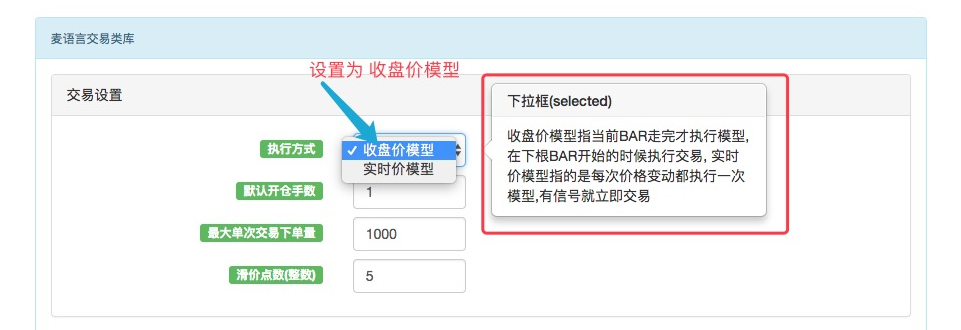
-
The closing model
The closing price model refers to executing the model at the end of the current BAR and executing the transaction at the beginning of the lower root BAR.
-
Real-time pricing model
Real-time price model refers to the execution of a model for each price change and the instantaneous trading of a signal. The real-time price model ignores the previous day's signals (the previous day's signals are executed immediately on the previous day), and the real-time price model only looks at the current market data to judge whether the signal is triggered.
-
-
The chart shows
-
Main additional indicators
Use the operator
^^, while assigning a variable, the setting indicator is shown on the main diagram.MA60^^MA(C, 60); // Ķ«Īń«ŚÕÅéµĢ░õĖ║60ńÜäÕØćń║┐µīćµĀć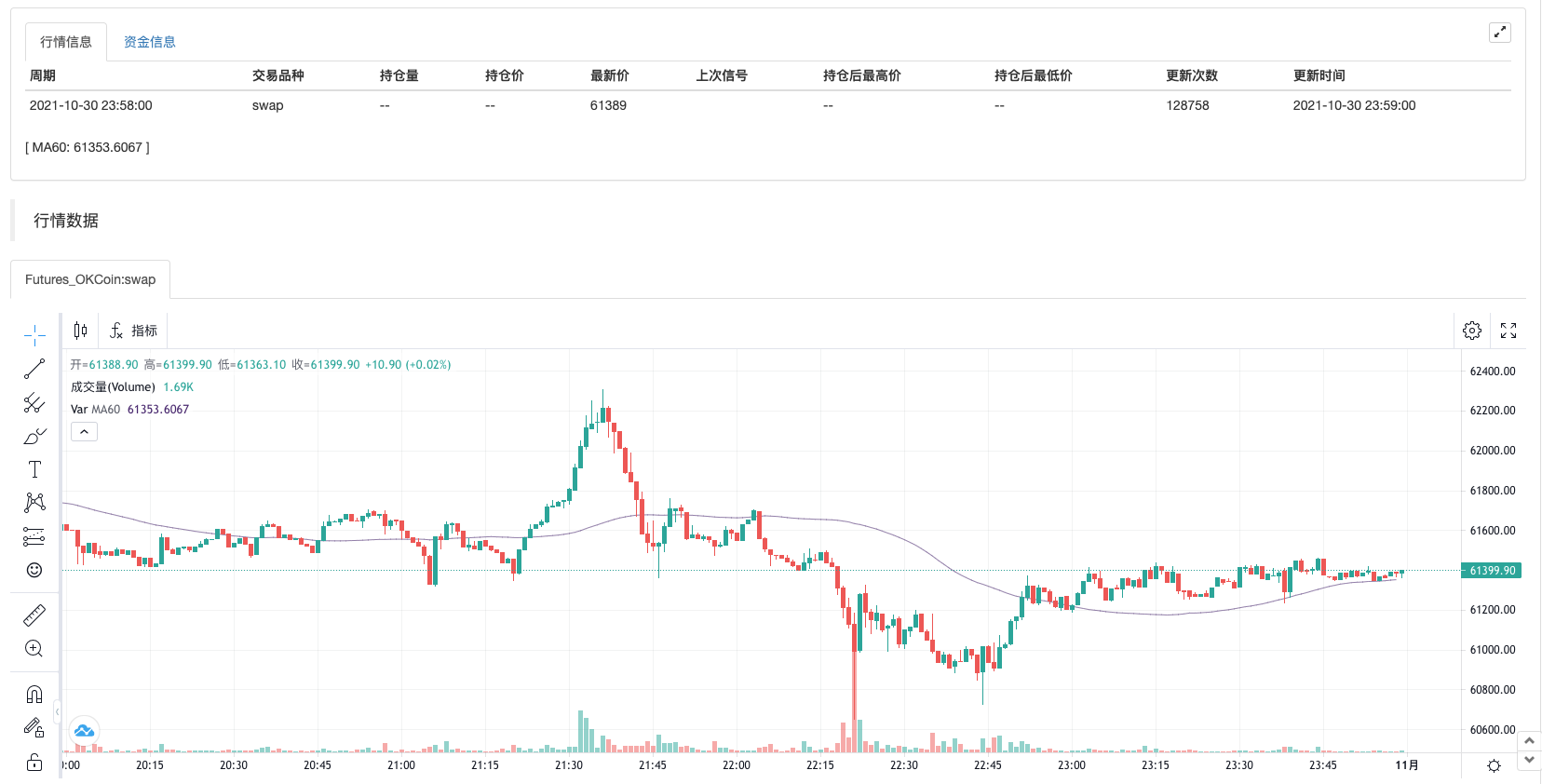
-
Supplementary indicators
Use the operator
:, while assigning a variable, the setting indicator is shown in the subgraph.ATR:MA(MAX(MAX((HIGH-LOW),ABS(REF(CLOSE,1)-HIGH)),ABS(REF(CLOSE,1)-LOW)),26); // ń╗ÖATRÕÅśķćÅĶĄŗÕĆ╝’╝ī":"ń¼”ÕÅĘÕÉÄõĖ║Ķ«Īń«ŚATRńÜäÕģ¼Õ╝Å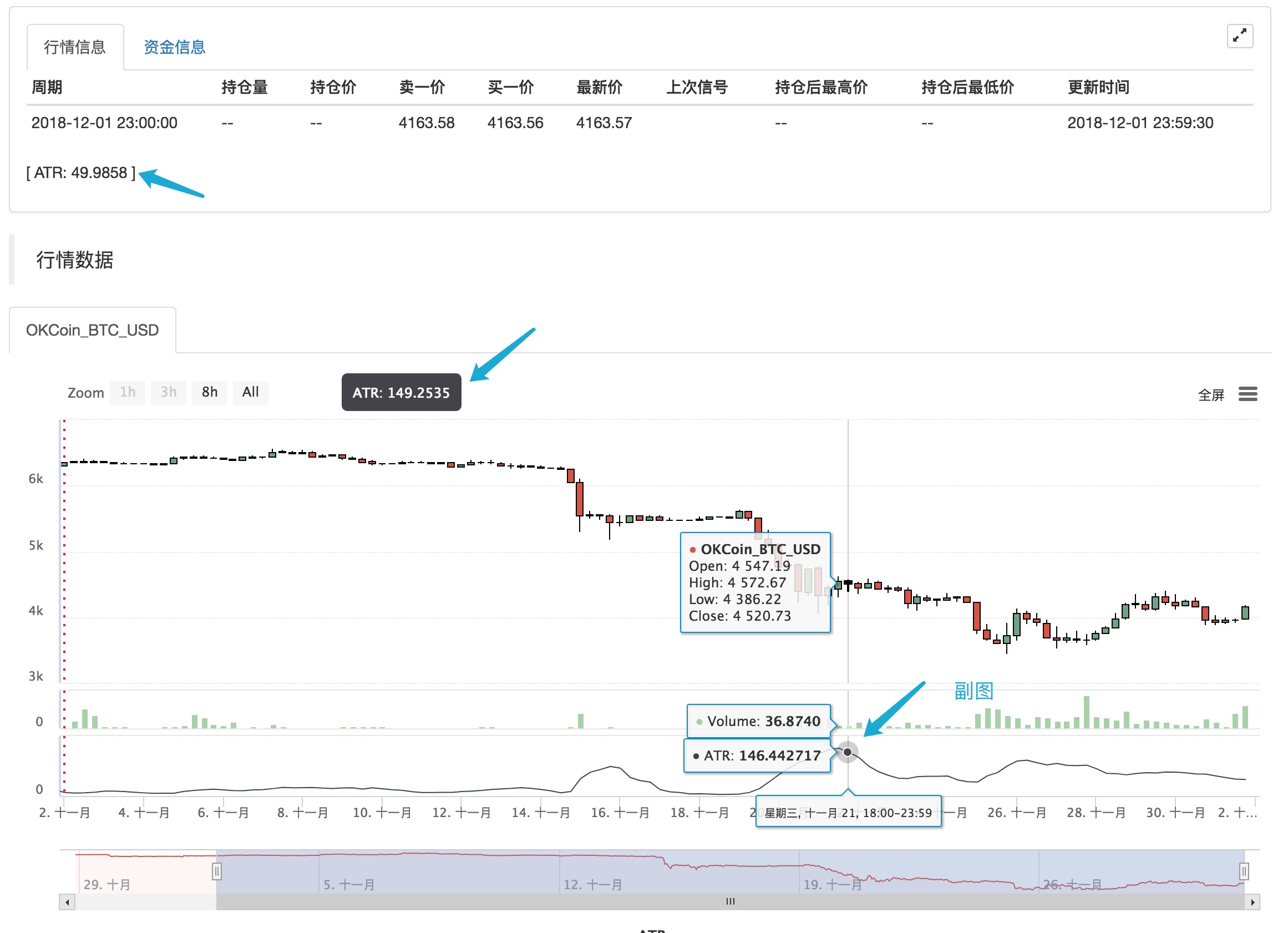
If you don't want it to show up on the main or sub-diagram, use the
... operator. MA60..MA(C, 60); // Ķ«Īń«ŚÕÅéµĢ░õĖ║60ńÜäÕØćń║┐µīćµĀć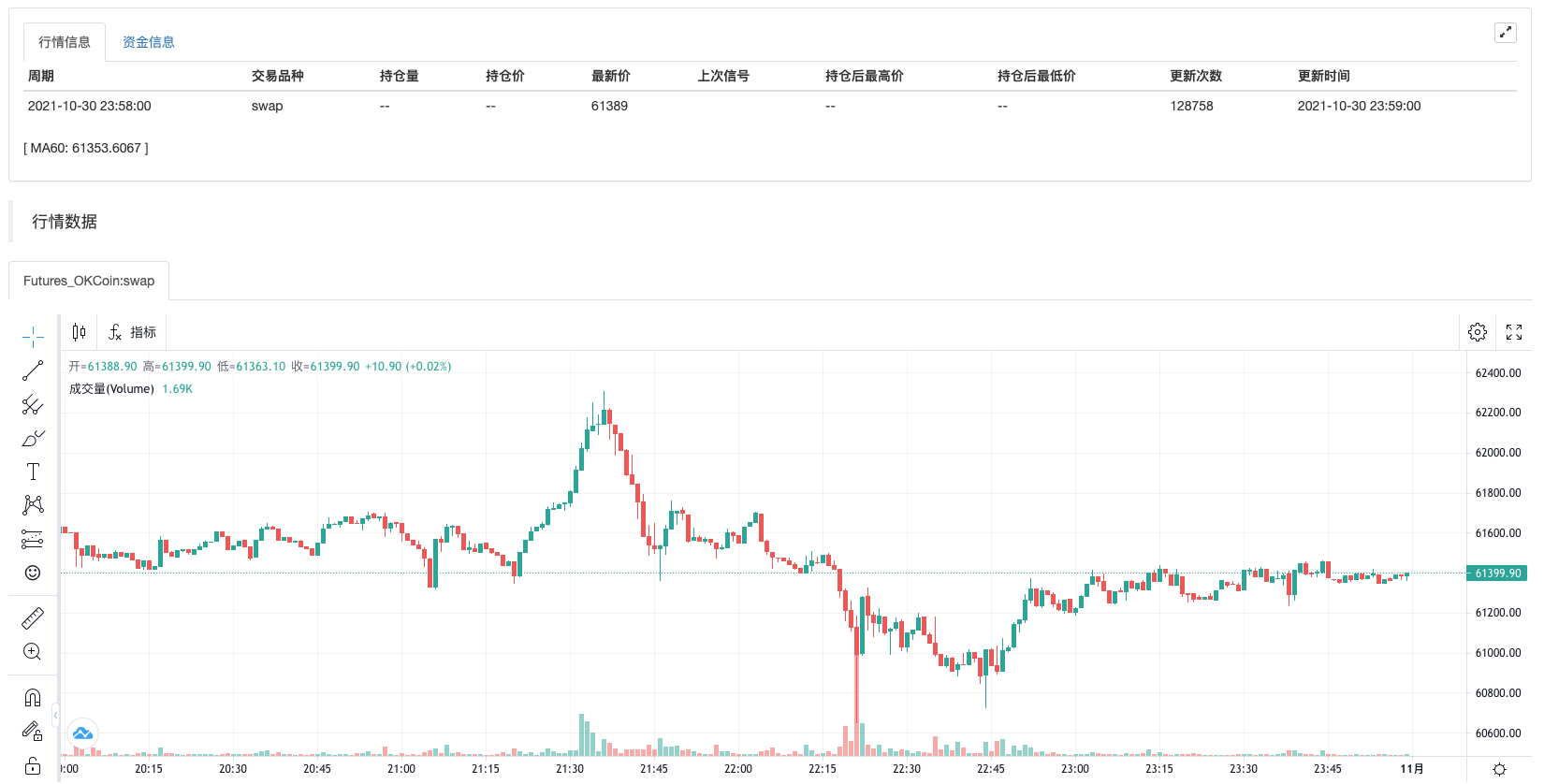
Can be used
DOTŃĆüCOLORREDSet the type, color, etc. of the lines to suit the habits of users who are familiar with the Malay language.
-
-
Frequently asked questions
Introduction to common problems encountered in the process of compiling indicatorsThe QuestionThis is a point that is usually taken into consideration when writing.
-
Pay attention to the score.
;The end of the story. -
Note that the system keyword cannot be used as a variable declaration.
-
Be careful with strings.Single quotation marksFor example:
'Õ╝Ćõ╗ō'This string. -
Notes
Notes
-
// µ│©ķćŖÕåģÕ«╣(English typing is allowed in the input method), representing code that is not compiled during execution, i.e. not executed//The following content, usually used to mark the meaning of the code, is easy to understand and remember when reviewing the code. -
{ µ│©ķćŖÕåģÕ«╣ }I'm not sure what to do.A:=MA(C,10); {õĖŖõĖĆĶĪīõ╗ŻńĀüµś»Ķ«Īń«ŚÕØćń║┐ŃĆé} -
(* µ│©ķćŖÕåģÕ«╣ *)I'm not sure what to do.A:=MA(C,10); (*õĖŖõĖĆĶĪīõ╗ŻńĀüµś»Ķ«Īń«ŚÕØćń║┐ŃĆé*)
-
-
Input method
When writing code, symbol errors are often caused by switching to English in the input method.
:The end sign.;The comma.,The brackets.()In the same way, these different characters need to be taken into account in the Chinese-English state.If you are using the search dog, Baidu, Bing input method, you can do it by clicking on one of the buttons.
shiftButton, quick switch from Chinese to English. -
Logic is easy.
- At least, not less than, not less than: corresponding relational operator
>=ŃĆé - Maximum, maximum, not exceed: corresponding relational operators
<=ŃĆé
- At least, not less than, not less than: corresponding relational operator
-
Policy to start synchronization
In a futures strategy, if a position is held manually before the strategy robot starts, the robot detects the position information when it starts, synchronizing it with the actual position status. It can be used in strategies.
SP’╝īBP’╝īCLOSEOUTThe order is to stand still.%% if (!scope.init) { var ticker = exchange.GetTicker(); exchange.Buy(ticker.Sell+10, 1); scope.init = true; } %% C>0, CLOSEOUT; -
Do not support bidirectional holding
The language does not support the same contract, but multiple empty holdings.
-
-
-
K-line data references
-
OPEN
Get the opening price of the K-string chart.
Opening price
Function: OPEN, abbreviated O
Parameters: none
Explanation: Return to the opening price of "The Cycle"
Sequence data
OPENÕÅ¢ÕŠŚKń║┐ÕøŠńÜäÕ╝Ćńøśõ╗ĘŃĆé µ│©’╝Ü 1ŃĆüÕÅ»ń«ĆÕåÖõĖ║OŃĆé õŠŗ1’╝Ü OO:=O; //Õ«Üõ╣ēOOõĖ║Õ╝Ćńøśõ╗Ę’╝øµ│©µäÅOõĖÄ0ńÜäÕī║Õł½ŃĆé õŠŗ2’╝Ü NN:=BARSLAST(DATE<>REF(DATE,1)); OO:=REF(O,NN); //ÕÅ¢ńÜäÕĮōµŚźńÜäÕ╝Ćńøśõ╗Ę õŠŗ3’╝Ü MA5:=MA(O,5); //Õ«Üõ╣ēÕ╝Ćńøśõ╗ĘńÜä5Õ橵£¤ÕØćń║┐’╝łOõĖ║OPENń«ĆÕåÖ’╝ēŃĆé -
HIGH
Get the highest price on the K-line chart.
Highest price
HIGH, abbreviated H
Parameters: none
Explanation: Returns the highest price of the "cycle"
Sequence data
HIGHÕÅ¢ÕŠŚKń║┐ÕøŠńÜäµ£Ćķ½śõ╗ĘŃĆé µ│©’╝Ü 1ŃĆüÕÅ»ń«ĆÕåÖõĖ║HŃĆé õŠŗ1’╝Ü HH:=H; // Õ«Üõ╣ēHHõĖ║µ£Ćķ½śõ╗Ę õŠŗ2’╝Ü HH:=HHV(H,5); // ÕÅ¢ńÜä5õĖ¬Õ橵£¤Õåģµ£Ćķ½śõ╗ĘńÜäµ£ĆÕż¦ÕĆ╝ õŠŗ3’╝Ü REF(H,1); // ÕÅ¢ńÜäÕēŹõĖƵĀ╣Kń║┐ńÜäµ£Ćķ½śõ╗Ę -
LOW
Get the lowest price for the K-line chart.
The lowest price
Function: LOW, abbreviated as L
Parameters: none
Explanation: Returns the lowest price of "the cycle"
Sequence data
LOWÕÅ¢ÕŠŚKń║┐ÕøŠńÜäµ£ĆõĮÄõ╗ĘŃĆé µ│©’╝Ü 1ŃĆüÕÅ»ń«ĆÕåÖõĖ║LŃĆé õŠŗ1’╝Ü LL:=L; // Õ«Üõ╣ēLLõĖ║µ£ĆõĮÄõ╗Ę õŠŗ2’╝Ü LL:=LLV(L,5); // ÕÅ¢ÕŠŚ5õĖ¬Õ橵£¤Õåģµ£ĆõĮÄõ╗ĘńÜäµ£ĆÕ░ÅÕĆ╝ õŠŗ3’╝Ü REF(L,1); // ÕÅ¢ÕŠŚÕēŹõĖƵĀ╣Kń║┐ńÜäµ£ĆõĮÄõ╗Ę -
CLOSE
Get the closing price of the K chart.
The closing price
Function: CLOSE, abbreviated as C
Parameters: none
Explanation: Return to the closing price of the cycle
Sequence data
CLOSEÕÅ¢ÕŠŚKń║┐ÕøŠńÜäµöČńøśõ╗Ę µ│©’╝Ü 1ŃĆüÕĮōńøśõĖŁkń║┐µ▓Īµ£ēĶĄ░Õ«īńÜ䵌ČÕĆÖ’╝īÕÅ¢ÕŠŚµ£Ćµ¢░õ╗ĘŃĆé 2ŃĆüÕÅ»ń«ĆÕåÖõĖ║CŃĆé õŠŗ1’╝Ü A:=CLOSE; //Õ«Üõ╣ēÕÅśķćÅAõĖ║µöČńøśõ╗Ę’╝łńøśõĖŁkń║┐µ▓Īµ£ēĶĄ░Õ«īńÜ䵌ČÕĆÖAõĖ║µ£Ćµ¢░õ╗Ę’╝ē õŠŗ2’╝Ü MA5:=MA(C,5); //Õ«Üõ╣ēµöČńøśõ╗ĘńÜä5Õ橵£¤ÕØćń║┐’╝łCõĖ║CLOSEń«ĆÕåÖ’╝ē õŠŗ3’╝Ü A:=REF(C,1); //ÕÅ¢ÕŠŚÕēŹõĖƵĀ╣kń║┐ńÜäµöČńøśõ╗Ę -
VOL
The transaction volume of the K-string graph is obtained.
Amount of transaction
Function: VOL, abbreviated V
Parameters: none
Explanation: Returns the transaction volume of the cycle
Sequence data
VOLÕÅ¢ÕŠŚKń║┐ÕøŠńÜ䵳Éõ║żķćÅŃĆé µ│©’╝Ü ÕÅ»ń«ĆÕåÖõĖ║VŃĆé Ķ»źÕćĮµĢ░Õ£©ÕĮōµĀ╣TICKõĖŖńÜäĶ┐öÕø×ÕĆ╝õĖ║ÕĮōÕż®µēƵ£ēTICKµłÉõ║żķćÅńÜäń┤»Ķ«ĪÕĆ╝ŃĆé õŠŗ1’╝Ü VV:=V; // Õ«Üõ╣ēVVõĖ║µłÉõ║żķćÅ õŠŗ2’╝Ü REF(V,1); // ĶĪ©ńż║ÕēŹõĖĆõĖ¬Õ橵£¤ńÜ䵳Éõ║żķćÅ õŠŗ3’╝Ü V>=REF(V,1); // µłÉõ║żķćÅÕż¦õ║ÄÕēŹõĖĆõĖ¬Õ橵£¤ńÜ䵳Éõ║żķćÅ’╝īĶĪ©ńż║µłÉõ║żķćÅÕó×ÕŖĀ(VõĖ║VOLńÜäń«ĆÕåÖ) -
OPI
The total holdings of the current futures (contract) market.
OpenInterest:OPI; -
REF
I'm going to go ahead and quote.
Õ╝Ģńö©XÕ£©NõĖ¬Õ橵£¤ÕēŹńÜäÕĆ╝ŃĆé µ│©’╝Ü 1ŃĆüÕĮōNõĖ║µ£ēµĢłÕĆ╝’╝īõĮåÕĮōÕēŹńÜäkń║┐µĢ░õĖŹĶČ│NµĀ╣’╝īĶ┐öÕø×ń®║ÕĆ╝’╝ø 2ŃĆüNõĖ║0µŚČĶ┐öÕø×ÕĮōÕēŹXÕĆ╝’╝ø 3ŃĆüNõĖ║ń®║ÕĆ╝µŚČĶ┐öÕø×ń®║ÕĆ╝ŃĆé 4ŃĆüNÕÅ»õ╗źõĖ║ÕÅśķćÅ õŠŗ1: REF(CLOSE,5);ĶĪ©ńż║Õ╝Ģńö©ÕĮōÕēŹÕ橵£¤ÕēŹń¼¼5õĖ¬Õ橵£¤ńÜäµöČńøśõ╗Ę õŠŗ2’╝Ü AA:=IFELSE(BARSBK>=1,REF(C,BARSBK),C);//ÕÅ¢µ£ĆĶ┐æõĖƵ¼Īõ╣░Õ╝Ćõ╗ōõ┐ĪÕÅĘKń║┐ńÜäµöČńøśõ╗Ę // 1’╝ēÕÅæÕć║BKõ┐ĪÕÅĘńÜäÕĮōµĀ╣kń║┐BARSBKĶ┐öÕø×ń®║ÕĆ╝,ÕłÖÕÅæÕć║BKõ┐ĪÕÅĘńÜäÕĮōµĀ╣kń║┐REF(C,BARSBK)Ķ┐öÕø× ń®║ÕĆ╝’╝ø // 2’╝ēÕÅæÕć║BKõ┐ĪÕÅĘńÜäÕĮōµĀ╣kń║┐BARSBKĶ┐öÕø×ń®║ÕĆ╝,õĖŹµ╗ĪĶČ│BARSBK>=1,ÕłÖÕĮōµĀ╣kń║┐ńÜäµöČńøśõ╗ĘŃĆé // 3’╝ēÕÅæÕć║BKõ┐ĪÕÅĘõ╣ŗÕÉÄńÜäkń║┐BARSBKĶ┐öÕø×õ╣░Õ╝Ćõ╗ōńÜäKń║┐ĶĘØń”╗ÕĮōÕēŹKń║┐ńÜäÕ橵£¤µĢ░’╝īREF(C,BARSBK) Ķ┐öÕø×Õ╝Ćõ╗ōkń║┐ńÜäµöČńøśõ╗ĘŃĆé // 4’╝ēõŠŗ’╝Ü1ŃĆü2ŃĆü3 õĖēµĀ╣kń║┐’╝ī1 Kń║┐õĖ║Õ╝Ćõ╗ōõ┐ĪÕÅĘńÜäÕĮōµĀ╣kń║┐’╝īÕłÖĶ┐öÕø×ÕĮōµĀ╣kń║┐ńÜäµöČńøśõ╗Ę’╝ī2ŃĆü3 Kń║┐Ķ┐öÕø× 1 Kń║┐ńÜäµöČńøśõ╗ĘŃĆé -
UNIT
The transaction unit that obtained the data contract.
ÕÅ¢µĢ░µŹ«ÕÉłń║”ńÜäõ║żµśōÕŹĢõĮŹŃĆé ńö©µ│Ģ’╝Ü UNIT ÕÅ¢ÕŖĀĶĮĮµĢ░µŹ«ÕÉłń║”ńÜäõ║żµśōÕŹĢõĮŹŃĆéCash in digital currency
The UNIT value is 1Ōüä2.
The future of digital currency
The UNIT value is related to the contract currency.
OKEXµ£¤Ķ┤¦ÕĖüµ£¼õĮŹÕÉłń║”’╝ÜBTCÕÉłń║”1Õ╝Āõ╗ŻĶĪ©100ńŠÄÕģā’╝īÕģČÕ«āÕĖüń¦ŹńÜä1Õ╝ĀÕÉłń║”õ╗ŻĶĪ©10ńŠÄÕģā -
MINPRICE
The minimum price change of the data contract.
ÕÅ¢µĢ░µŹ«ÕÉłń║”ńÜäµ£ĆÕ░ÅÕÅśÕŖ©õ╗ĘõĮŹŃĆé ńö©µ│Ģ’╝Ü MINPRICE; ÕÅ¢ÕŖĀĶĮĮµĢ░µŹ«ÕÉłń║”ńÜäµ£ĆÕ░ÅÕÅśÕŖ©õ╗ĘõĮŹŃĆé -
MINPRICE1
The minimum price change of the transaction contract.
ÕÅ¢õ║żµśōÕÉłń║”ńÜäµ£ĆÕ░ÅÕÅśÕŖ©õ╗ĘõĮŹŃĆé ńö©µ│Ģ’╝Ü MINPRICE1; ÕÅ¢õ║żµśōÕÉłń║”ńÜäµ£ĆÕ░ÅÕÅśÕŖ©õ╗ĘõĮŹŃĆé
-
-
The time function
-
BARPOS
Find the position of the K line.
BARPOS’╝īĶ┐öÕø×õ╗Äń¼¼õĖƵĀ╣Kń║┐Õ╝ĆÕ¦ŗÕł░ÕĮōÕēŹńÜäÕ橵£¤µĢ░ŃĆé µ│©’╝Ü 1ŃĆüBARPOSĶ┐öÕø×µ£¼Õ£░ÕĘ▓µ£ēńÜäKń║┐µĀ╣µĢ░’╝īõ╗ĵ£¼µ£║õĖŖÕŁśÕ£©ńÜäµĢ░µŹ«Õ╝ĆÕ¦ŗń«ŚĶĄĘŃĆé 2ŃĆüµ£¼µ£║ÕĘ▓µ£ēńÜäń¼¼õĖƵĀ╣Kń║┐õĖŖĶ┐öÕø×ÕĆ╝õĖ║1ŃĆé õŠŗ1’╝ÜLLV(L,BARPOS); // µ▒éµ£¼Õ£░ÕĘ▓µ£ēµĢ░µŹ«ńÜäµ£ĆÕ░ÅÕĆ╝ŃĆé õŠŗ2’╝ÜIFELSE(BARPOS=1,H,0); // ÕĮōÕēŹKń║┐µś»µ£¼µ£║ÕĘ▓µ£ēńÜäń¼¼õĖƵĀ╣Kń║┐ÕÅ¢µ£Ćķ½śÕĆ╝’╝īÕÉ”ÕłÖÕÅ¢0ŃĆé -
DAYBARPOS
DAYBARPOS if the root K line BAR is the tenth K line BAR of the day.
-
PERIOD
The cycle value is the number of minutes.
1, 3, 5, 15, 30, 60, 1440 -
DATE
The dateThe DATE function returns the date of the year of the cycle from 1900 onwards.
õŠŗ1’╝Ü AA..DATE; // µĄŗĶ»ĢµŚČAAńÜäÕĆ╝õĖ║220218’╝īĶĪ©ńż║2022Õ╣┤2µ£ł18µŚź -
TIME
Take the time of the K line.
TIME’╝īÕÅ¢Kń║┐µŚČķŚ┤ŃĆé µ│©’╝Ü 1ŃĆüĶ»źÕćĮµĢ░Õ£©ńøśõĖŁÕ«×µŚČĶ┐öÕø×’╝īÕ£©Kń║┐ĶĄ░Õ«īÕÉÄĶ┐öÕø×Kń║┐ńÜäĶĄĘÕ¦ŗµŚČķŚ┤ŃĆé 2ŃĆüĶ»źÕćĮµĢ░Ķ┐öÕø×ńÜ䵜»õ║żµśōµēƵĢ░µŹ«µÄźµöȵŚČķŚ┤’╝īõ╣¤Õ░▒µś»õ║żµśōµēƵŚČķŚ┤ŃĆé 3ŃĆüTIMEÕćĮµĢ░Õ£©ń¦ÆÕ橵£¤õĮ┐ńö©µŚČĶ┐öÕø×ÕģŁõĮŹµĢ░ńÜäÕĮóÕ╝Å’╝īÕŹ│’╝ÜHHMMSS’╝īÕ£©ÕģČõ╗¢Õ橵£¤õĖŖµśŠńż║õĖ║ÕøøõĮŹµĢ░ńÜäÕĮóÕ╝Å’╝īÕŹ│’╝ÜHHMM. 4ŃĆüTIMEÕćĮµĢ░ÕŬĶāĮÕŖĀĶĮĮÕ£©µŚźÕ橵£¤õ╗źõĖŗńÜäÕ橵£¤õĖŁ’╝īÕ£©µŚźÕ橵£¤ÕÅŖµŚźÕ橵£¤õ╗źõĖŖńÜäÕ橵£¤õĖŁĶ»źÕćĮµĢ░Ķ┐öÕø×ÕĆ╝Õ¦ŗń╗łõĖ║1500ŃĆé 5ŃĆüõĮ┐ńö©TIMEÕćĮµĢ░Ķ┐øĶĪīÕ░ŠńøśÕ╣│õ╗ōńÜäµōŹõĮ£ķ£ĆĶ”üµ│©µäÅ ’╝ł1’╝ēÕ░ŠńøśÕ╣│õ╗ōĶ«ŠńĮ«ńÜ䵌ČķŚ┤Õ╗║Ķ««Ķ«ŠńĮ«õĖ║Kń║┐Ķ┐öÕø×ÕĆ╝õĖŁÕ«×ķÖģÕÅ»õ╗źÕÅ¢Õł░ńÜ䵌ČķŚ┤’╝łÕ”é’╝ÜĶ×║ń║╣µīćµĢ░ 5ÕłåķƤÕ橵£¤ µ£ĆÕÉÄõĖƵĀ╣Kń║┐Ķ┐öÕø×µŚČķŚ┤õĖ║1455’╝īÕ░ŠńøśÕ╣│õ╗ōĶ«ŠńĮ«õĖ║TIME>=1458,CLOSEOUT;ÕłÖµĢłµ×£µĄŗĶ»ĢõĖŁõĖŹĶāĮÕć║ńÄ░Õ░ŠńøśÕ╣│õ╗ōńÜäõ┐ĪÕÅĘ’╝ē ’╝ł2’╝ēõĮ┐ńö©TIMEÕćĮµĢ░õĮ£õĖ║Õ░ŠńøśÕ╣│õ╗ōńÜäµØĪõ╗ČńÜä’╝īÕ╗║Ķ««Õ╝Ćõ╗ōµØĪõ╗Čõ╣¤Ķ”üÕüÜńøĖÕ║öńÜ䵌ČķŚ┤ķÖÉÕłČ’╝łÕ”éĶ«ŠńĮ«Õ░ŠńøśÕ╣│õ╗ōµØĪõ╗ČõĖ║TIME>=1458,CLOSEOUT;ÕłÖńøĖÕ║öńÜäÕ╝Ćõ╗ōµØĪõ╗ČõĖŁķ£ĆĶ”üµĘ╗ÕŖĀµØĪõ╗ČTIME<1458’╝øķü┐ÕģŹÕ╣│õ╗ōÕÉÄÕåŹµ¼ĪÕ╝Ćõ╗ōńÜäµāģÕåĄ’╝ē õŠŗ1: C>O&&TIME<1450,BK; C<O&&TIME<1450,SK; TIME>=1450,SP; TIME>=1450,BP; AUTOFILTER; // Õ£©14:50ÕÉÄÕ╣│õ╗ōŃĆé õŠŗ2’╝Ü ISLASTSK=0&&C>O&&TIME>=0915,SK; -
YEAR
The year.
YEAR’╝īÕÅ¢ÕŠŚÕ╣┤õ╗ĮŃĆé µ│©’╝Ü YEARńÜäÕÅ¢ÕĆ╝ĶīāÕø┤õĖ║1970ŌĆö2033ŃĆé õŠŗ1’╝Ü N:=BARSLAST(YEAR<>REF(YEAR,1))+1; HH:=REF(HHV(H,N),N); LL:=REF(LLV(L,N),N); OO:=REF(VALUEWHEN(N=1,O),N); CC:=REF(C,N); // ÕÅ¢õĖŖõĖĆÕ╣┤ńÜäµ£Ćķ½śõ╗Ę’╝īµ£ĆõĮÄõ╗Ę’╝īÕ╝Ćńøśõ╗Ę’╝īµöČńøśõ╗Ę õŠŗ2’╝Ü NN:=IFELSE(YEAR>=2000 AND MONTH>=1,0,1); -
MONTH
The month is taken.
MONTH’╝īĶ┐öÕø×µ¤ÉõĖ¬Õ橵£¤ńÜäµ£łõ╗ĮŃĆé µ│©’╝Ü MONTHńÜäÕÅ¢ÕĆ╝ĶīāÕø┤õĖ║1ŌĆö12. õŠŗ1’╝Ü VALUEWHEN(MONTH=3&&DAY=1,C); // Õ£©Kń║┐µŚźµ£¤õĖ║õĖēµ£łõĖƵŚźµŚČÕÅ¢ÕģȵöČńøśõ╗Ę õŠŗ2’╝Ü C>=VALUEWHEN(MONTH<REF(MONTH,1),O),SP; -
DAY
Number of days in a cycle
DAY,Ķ┐öÕø×µ¤ÉõĖĆÕ橵£¤ńÜ䵌źµĢ░ŃĆé µ│©’╝Ü DAYÕÅ¢ÕĆ╝ĶīāÕø┤õĖ║1-31ŃĆé õŠŗ1’╝Ü DAY=3&&TIME=0915’╝īBK; // ÕĮōµŚźĶĄĘõĖ║3µŚź’╝īµŚČķŚ┤õĖ║9ńé╣15ÕłåµŚČ’╝īõ╣░Õ╝Ć õŠŗ2’╝Ü N:=BARSLAST(DATE<>REF(DATE,1))+1; CC:=IFELSE(DAY=1,VALUEWHEN(N=1,O),0); // ÕĮōµŚźµ£¤õĖ║1µŚČ’╝īÕÅ¢Õ╝Ćńøśõ╗Ę’╝īÕÉ”ÕłÖÕÅ¢ÕĆ╝õĖ║0 -
HOUR
The hour.
HOUR’╝īĶ┐öÕø×µ¤ÉÕ橵£¤ńÜäÕ░ŵŚČµĢ░ŃĆé µ│©’╝Ü HOURńÜäÕÅ¢ÕĆ╝ĶīāÕø┤õĖ║0ŌĆö23 õŠŗ1’╝Ü HOUR=10; // Õ£©10:00ńÜäKń║┐õĖŖĶ┐öÕø×ÕĆ╝õĖ║1’╝īÕģČõĮÖKń║┐õĖŖĶ┐öÕø×ÕĆ╝õĖ║0 -
MINUTE
I'm not going to lie.
MINUTE,Ķ┐öÕø×µ¤ÉõĖ¬Õ橵£¤ńÜäÕłåķƤµĢ░ŃĆé µ│©’╝Ü 1’╝ÜMINUTEńÜäÕÅ¢ÕĆ╝ĶīāÕø┤õĖ║0ŌĆö59 2’╝ÜĶ»źÕćĮµĢ░ÕŬĶāĮÕŖĀĶĮĮÕ£©ÕłåķƤÕ橵£¤õĖŖ’╝īĶ┐öÕø×ÕĮōµĀ╣Kń║┐Õ╝ĆÕ¦ŗńÜäÕłåķƤµĢ░ŃĆé õŠŗ1’╝Ü MINUTE=0’╝ø // Õ£©µĢ┤ńé╣µŚČÕł╗ńÜäÕłåķƤKń║┐õĖŖĶ┐öÕø×ÕĆ╝õĖ║1’╝īÕģČõĮÖKń║┐Ķ┐öÕø×ÕĆ╝õĖ║0 õŠŗ2’╝Ü TIME>1400&&MINUTE=50,SP; // Õ£©14:50ńÜ䵌ČÕĆÖÕŹ¢Õ╣│õ╗ō -
WEEKDAY
The number of weeks is given here.
WEEKDAY,ÕÅ¢ÕŠŚµś¤µ£¤µĢ░ŃĆé µ│©’╝Ü 1’╝ÜWEEKDAYńÜäÕÅ¢ÕĆ╝ĶīāÕø┤µś»0ŌĆö6ŃĆé(µś¤µ£¤µŚź ~ µś¤µ£¤ÕģŁ) õŠŗ1’╝Ü N:=BARSLAST(MONTH<>REF(MONTH,1))+1; COUNT(WEEKDAY=5,N)=3&&TIME>=1450,BP; COUNT(WEEKDAY=5,N)=3&&TIME>=1450,SP; AUTOFILTER; // µ»ÅõĖ¬µ£łõ║żÕē▓µŚźÕ░ŠńøśĶć¬ÕŖ©Õ╣│õ╗ō õŠŗ2’╝Ü C>VALUEWHEN(WEEKDAY<REF(WEEKDAY,1),O)+10,BK; AUTOFILTER;
-
-
Logical judgment functions
-
BARSTATUS
Returns the position state of the current cycle.
BARSTATUS Ķ┐öÕø×ÕĮōÕēŹÕ橵£¤ńÜäõĮŹńĮ«ńŖȵĆüŃĆé µ│©’╝Ü Ķ»źÕćĮµĢ░Ķ┐öÕø×1ĶĪ©ńż║ÕĮōÕēŹÕ橵£¤µś»ń¼¼õĖĆõĖ¬Õ橵£¤’╝īĶ┐öÕø×2ĶĪ©ńż║µś»µ£ĆÕÉÄõĖĆõĖ¬Õ橵£¤’╝īĶ┐öÕø×0ĶĪ©ńż║ÕĮōÕēŹÕ橵£¤Õżäõ║ÄõĖŁķŚ┤õĮŹńĮ«ŃĆé õŠŗ: A:=IFELSE(BARSTATUS=1,H,0); // Õ”éµ×£ÕĮōÕēŹKń║┐µś»ń¼¼õĖĆõĖ¬Õ橵£¤’╝īÕÅśķćÅAĶ┐öÕø×Kń║┐µ£Ćķ½śÕĆ╝’╝īÕÉ”ÕłÖÕÅ¢0 -
BETWEEN
I'm not going to lie.
BETWEEN(X,Y,Z) ĶĪ©ńż║Xµś»ÕÉ”Õżäõ║ÄYÕÆīZõ╣ŗķŚ┤’╝īµłÉń½ŗĶ┐öÕø×1(Yes)’╝īÕÉ”ÕłÖĶ┐öÕø×0(No)ŃĆé µ│©’╝Ü 1ŃĆüÕģČõĖŁĶŗźX=YŃĆüX=ZŃĆüµł¢X=YõĖöY=ZµŚČÕćĮµĢ░Ķ┐öÕø×ÕĆ╝õĖ║1(Yse)ŃĆé õŠŗ1’╝Ü BETWEEN(CLOSE,MA5,MA10); // ĶĪ©ńż║µöČńøśõ╗Ęõ╗ŗõ║Ä5µŚźÕØćń║┐õĖÄ10µŚźÕØćń║┐õ╣ŗķŚ┤ -
BARSLASTCOUNT
BARSLASTCOUNT (COND) Calculates the number of cycles from the current cycle onwards, statistically counting the number of cycles that satisfy the condition continuously.
µ│©’╝Ü 1ŃĆüĶ┐öÕø×ÕĆ╝õĖ║õ╗ÄÕĮōÕēŹÕ橵£¤Ķ«Īń«ŚCONDĶ┐×ń╗ŁõĖŹõĖ║0ńÜäÕ橵£¤µĢ░ 2ŃĆüµØĪõ╗Čń¼¼õĖƵ¼ĪµłÉń½ŗńÜäÕĮōµĀ╣kń║┐õĖŖBARSLASTCOUNT(COND)ńÜäĶ┐öÕø×ÕĆ╝õĖ║1 õŠŗ’╝Ü BARSLASTCOUNT(CLOSE>OPEN); //Ķ«Īń«ŚÕĮōµĀ╣Kń║┐Õ£©ÕåģĶ┐×ń╗ŁõĖ║ķś│ń║┐ńÜäÕ橵£¤µĢ░ -
CROSS
Cross functions are also called cross functions.
CROSS(A,B) ĶĪ©ńż║Aõ╗ÄõĖŗµ¢╣ÕÉæõĖŖń®┐Ķ┐ćB’╝īµłÉń½ŗĶ┐öÕø×1(Yes)’╝īÕÉ”ÕłÖĶ┐öÕø×0(No) µ│©’╝Ü 1ŃĆüµ╗ĪĶČ│ń®┐ĶČŖńÜäµØĪõ╗ČÕ┐ģķĪ╗õĖŖµĀ╣kń║┐µ╗ĪĶČ│A<=B’╝īÕĮōµĀ╣kń║┐µ╗ĪĶČ│A>BµēŹĶó½Ķ«żÕ«ÜõĖ║ń®┐ĶČŖŃĆé õŠŗ1’╝Ü CROSS(CLOSE,MA(CLOSE,5)); // ĶĪ©ńż║µöČńøśń║┐õ╗ÄõĖŗµ¢╣ÕÉæõĖŖń®┐Ķ┐ć5Õ橵£¤ÕØćń║┐ -
CROSSDOWN
Going down.
CROSSDOWN(A,B)’╝ÜĶĪ©ńż║ÕĮōAõ╗ÄõĖŖµ¢╣ÕÉæõĖŗń®┐B’╝īµłÉń½ŗĶ┐öÕø×1(Yes)’╝īÕÉ”ÕłÖĶ┐öÕø×0(No) µ│©’╝Ü 1ŃĆüCROSSDOWN(A,B)ńŁēÕÉīõ║ÄCROSS(B,A)’╝īCROSSDOWN(A,B)ń╝¢ÕåÖµø┤Õł®õ║ÄńÉåĶ¦Ż õŠŗ1’╝Ü MA5:=MA(C,5); MA10:=MA(C,10); CROSSDOWN(MA5,MA10),SK; // MA5õĖŗń®┐MA10ÕŹ¢Õ╝Ćõ╗ō // CROSSDOWN(MA5,MA10),SK;õĖÄCROSSDOWN(MA5,MA10)=1,SK;ĶĪ©ĶŠŠÕÉīńŁēµäÅõ╣ē -
CROSSUP
I'm going to cross over.
CROSSUP(A,B)ĶĪ©ÕĮōAõ╗ÄõĖŗµ¢╣ÕÉæõĖŖń®┐Ķ┐ćB’╝īµłÉń½ŗĶ┐öÕø×1(Yes)’╝īÕÉ”ÕłÖĶ┐öÕø×0(No) µ│©’╝Ü 1ŃĆüCROSSUP(A,B)ńŁēÕÉīõ║ÄCROSS(A,B)’╝īCROSSUP(A,B)ń╝¢ÕåÖµø┤Õł®õ║ÄńÉåĶ¦ŻŃĆé õŠŗ1’╝Ü MA5:=MA(C,5); MA10:=MA(C,10); CROSSUP(MA5,MA10),BK; // MA5õĖŖń®┐MA10’╝īõ╣░Õ╝Ćõ╗ō // CROSSUP(MA5,MA10),BK;õĖÄCROSSUP(MA5,MA10)=1,BK;ĶĪ©ĶŠŠÕÉīńŁēµäÅõ╣ē -
EVERY
It's not just about what you're going to do.
EVERY(COND,N)’╝īÕłżµ¢ŁNÕ橵£¤Õåģµś»ÕÉ”õĖĆńø┤µ╗ĪĶČ│CONDµØĪõ╗ČŃĆéĶŗźµ╗ĪĶČ│ÕćĮµĢ░Ķ┐öÕø×ÕĆ╝õĖ║1’╝īõĖŹµ╗ĪĶČ│ÕćĮµĢ░Ķ┐öÕø×ÕĆ╝õĖ║0ŃĆé µ│©’╝Ü 1ŃĆüNÕīģÕɽÕĮōÕēŹkń║┐ŃĆé 2ŃĆüĶŗźNµś»µ£ēµĢłµĢ░ÕĆ╝’╝īõĮåÕēŹķØóµ▓Īµ£ēķéŻõ╣łÕżÜKń║┐,µł¢ĶĆģNõĖ║ń®║ÕĆ╝’╝īõ╗ŻĶĪ©µØĪõ╗ČõĖŹµ╗ĪĶČ│’╝īÕćĮµĢ░Ķ┐öÕø×ÕĆ╝õĖ║0ŃĆé 3ŃĆüNÕÅ»õ╗źµś»ÕÅśķćÅŃĆé õŠŗ1’╝Ü EVERY(CLOSE>OPEN,5); // ĶĪ©ńż║5õĖ¬Õ橵£¤ÕåģõĖĆńø┤µś»ķś│ń║┐ õŠŗ2’╝Ü MA5:=MA(C,5); // Õ«Üõ╣ē5Õ橵£¤ÕØćń║┐ MA10:=MA(C,10); // Õ«Üõ╣ē10Õ橵£¤ÕØćń║┐ EVERY(MA5>MA10,4),BK; // 4õĖ¬Õ橵£¤ÕåģMA5ķāĮÕż¦õ║ÄMA10’╝īÕłÖõ╣░Õ╝Ćõ╗ō // EVERY(MA5>MA10,4),BK;õĖÄEVERY(MA5>MA10,4)=1,BK;ĶĪ©ĶŠŠÕÉīńŁēµäÅõ╣ē -
EXIST
Judging whether there is satisfaction.
EXIST(COND,N)Õłżµ¢ŁNõĖ¬Õ橵£¤Õåģµś»ÕÉ”µ£ēµ╗ĪĶČ│CONDńÜäµØĪõ╗ČŃĆé µ│©: 1ŃĆüNÕīģÕɽÕĮōÕēŹkń║┐ŃĆé 2ŃĆüNÕÅ»õ╗źµś»ÕÅśķćÅŃĆé 3ŃĆüĶŗźNµś»µ£ēµĢłµĢ░ÕĆ╝’╝īõĮåÕēŹķØóµ▓Īµ£ēķéŻõ╣łÕżÜKń║┐’╝īµīēÕ«×ķÖģÕ橵£¤µĢ░Ķ«Īń«ŚŃĆé õŠŗ1’╝Ü EXIST(CLOSE>REF(HIGH,1),10); // ĶĪ©ńż║10õĖ¬Õ橵£¤õĖŁµś»ÕÉ”ÕŁśÕ£©µöČńøśõ╗ĘÕż¦õ║ÄÕēŹõĖĆõĖ¬Õ橵£¤ńÜäµ£Ćķ½śõ╗Ę’╝īÕŁśÕ£©Ķ┐öÕø×1’╝īõĖŹÕŁśÕ£©ÕłÖĶ┐öÕø×0 õŠŗ2’╝Ü N:=BARSLAST(DATE<>REF(DATE,1))+1; EXIST(C>MA(C,5),N); // ĶĪ©ńż║ÕĮōÕż®µś»ÕÉ”µ£ēµ╗ĪĶČ│µöČńøśõ╗ĘÕż¦õ║Ä5Õ橵£¤ÕØćń║┐ńÜäkń║┐’╝īÕŁśÕ£©Ķ┐öÕø×1’╝īõĖŹÕŁśÕ£©Ķ┐öÕø×0 -
IF
The conditional function.
IF(COND,A,B)ĶŗźCONDµØĪõ╗ȵłÉń½ŗ’╝īÕłÖĶ┐öÕø×A’╝īÕÉ”ÕłÖĶ┐öÕø×BŃĆé µ│©’╝Ü 1ŃĆüCONDµś»Õłżµ¢ŁµØĪõ╗Č;AŃĆüBÕÅ»õ╗źµś»µØĪõ╗Č’╝īõ╣¤ÕÅ»õ╗źµś»µĢ░ÕĆ╝ŃĆé 2ŃĆüĶ»źÕćĮµĢ░µö»µīüÕÅśķćÅÕŠ¬ńÄ»Õ╝Ģńö©ÕēŹõĖĆÕ橵£¤Ķć¬Ķ║½ÕÅśķćÅ’╝īÕŹ│µö»µīüõĖŗķØóĶ┐ÖµĀĘńÜäÕåÖµ│ĢY’╝ÜIF(CON,X,REF(Y,1))ŃĆé õŠŗ1’╝Ü IF(ISUP,H,L); // kń║┐õĖ║ķś│ń║┐’╝īÕÅ¢µ£Ćķ½śõ╗Ę’╝īÕÉ”ÕłÖÕÅ¢µ£ĆõĮÄõ╗Ę õŠŗ2’╝Ü A:=IF(MA5>MA10,CROSS(DIFF,DEA),IF(CROSS(D,K),2,0)); // ÕĮōMA5>MA10µŚČ’╝īÕÅ¢µś»ÕÉ”µ╗ĪĶČ│DIFFõĖŖń®┐DEA’╝īÕÉ”ÕłÖ(MA5õĖŹÕż¦õ║ÄMA10)’╝īÕĮōK,DµŁ╗ÕÅēµŚČ’╝īõ╗żAĶĄŗÕĆ╝õĖ║2’╝īĶŗźõĖŖĶ┐░µØĪõ╗ČķāĮõĖŹµ╗ĪĶČ│’╝īAĶĄŗÕĆ╝õĖ║0 A=1,BPK; // ÕĮōMA5>MA10’╝īõ╗źDIFFõĖŖń®┐DEAõĮ£õĖ║Õ╝ĆÕżÜõ╗ōµØĪõ╗Č A=2,SPK; // ÕĮōMA5õĖŹÕż¦õ║ÄMA10’╝īõ╗źKŃĆüDµŁ╗ÕÅēõĮ£õĖ║Õ╝Ćń®║õ╗ōµØĪõ╗Č -
IFELSE
The conditional function.
IFELSE(COND,A,B) ĶŗźCONDµØĪõ╗ȵłÉń½ŗ’╝īÕłÖĶ┐öÕø×A’╝īÕÉ”ÕłÖĶ┐öÕø×BŃĆé µ│©’╝Ü 1ŃĆüCONDµś»Õłżµ¢ŁµØĪõ╗Č;AŃĆüBÕÅ»õ╗źµś»µØĪõ╗Č’╝īõ╣¤ÕÅ»õ╗źµś»µĢ░ÕĆ╝ŃĆé 2ŃĆüĶ»źÕćĮµĢ░µö»µīüÕÅśķćÅÕŠ¬ńÄ»Õ╝Ģńö©ÕēŹõĖĆÕ橵£¤Ķć¬Ķ║½ÕÅśķćÅ’╝īÕŹ│µö»µīüõĖŗķØóĶ┐ÖµĀĘńÜäÕåÖµ│ĢY: IFELSE(CON,X,REF(Y,1)); õŠŗ1’╝Ü IFELSE(ISUP,H,L); // kń║┐õĖ║ķś│ń║┐’╝īÕÅ¢µ£Ćķ½śõ╗Ę’╝īÕÉ”ÕłÖÕÅ¢µ£ĆõĮÄõ╗Ę õŠŗ2’╝Ü A:=IFELSE(MA5>MA10,CROSS(DIFF,DEA),IFELSE(CROSS(D,K),2,0)); // ÕĮōMA5>MA10µŚČ’╝īÕÅ¢µś»ÕÉ”µ╗ĪĶČ│DIFFõĖŖń®┐DEA’╝īÕÉ”ÕłÖ(MA5õĖŹÕż¦õ║ÄMA10)’╝īÕĮōK,DµŁ╗ÕÅēµŚČ’╝īõ╗żAĶĄŗÕĆ╝õĖ║2’╝īĶŗźõĖŖĶ┐░µØĪõ╗ČķāĮõĖŹµ╗ĪĶČ│’╝īAĶĄŗÕĆ╝õĖ║0 A=1,BPK; // ÕĮōMA5>MA10’╝īõ╗źDIFFõĖŖń®┐DEAõĮ£õĖ║Õ╝ĆÕżÜõ╗ōµØĪõ╗Č A=2,SPK; // ÕĮōMA5õĖŹÕż¦õ║ÄMA10’╝īõ╗źKŃĆüDµŁ╗ÕÅēõĮ£õĖ║Õ╝Ćń®║õ╗ōµØĪõ╗Č -
ISCONTRACT
Whether the contract is currently in force or not.
ISCONTRACT(CODE)ÕĮōÕēŹµś»ÕÉ”õĖ║µīćÕ«ÜńÜäÕÉłń║”ŃĆé ńö©µ│Ģ’╝ÜISCONTRACT(CODE);µś»ÕĮōÕēŹÕÉłń║”Ķ┐öÕø×1’╝īõĖŹµś»ÕĮōÕēŹÕÉłń║”Ķ┐öÕø×0ŃĆé µ│©’╝Ü 1ŃĆüÕłżµ¢Łµś»ÕÉ”õĖ║µīćÕ«ÜÕÉłń║”µŚČ’╝īCODEÕÅ»õ╗źõĖ║ÕÉłń║”ńÜäõ║żµśōõ╗ŻńĀüŃĆé õŠŗ: ISCONTRACT('this_week'); // µĢ░ÕŁŚĶ┤¦ÕĖüOKEXµ£¤Ķ┤¦ÕÉłń║” ISCONTRACT('XBTUSD'); // µĢ░ÕŁŚĶ┤¦ÕĖüBITMEXµ£¤Ķ┤¦ÕÉłń║”Support for regular expressions.
Judging the Contract
ISCONTRACT('this_week'); // Õłżµ¢ŁÕĮōÕēŹÕÉłń║”µś»ÕÉ”õĖ║OKEXµ£¤Ķ┤¦ this_week’╝łÕĮōÕæ©’╝ēÕÉłń║”Determine the name of the exchange
ISCONTRACT('@Futures_(Binance|FTX)'); // Õłżµ¢ŁÕĮōÕēŹõ║żµśōµēĆÕ»╣Ķ▒Īµś»ÕÉ”õĖ║Binanceµ£¤Ķ┤¦µł¢ĶĆģFTXµ£¤Ķ┤¦ ISCONTRACT('@(OKEX|Bitfinex)'); // Õłżµ¢Łõ║żµśōµēĆ’╝īķ£ĆĶ”üÕ£©Õ╝ĆÕż┤ÕŖĀ@ÕŁŚń¼” -
ISDOWN
I'm not going to tell you about it.
ISDOWNÕłżµ¢ŁĶ»źÕ橵£¤µś»ÕÉ”µöČķś┤ŃĆé µ│©’╝Ü 1ŃĆüISDOWNńŁēÕÉīõ║ÄC<O õŠŗ’╝Ü ISDOWN=1&&C<REF(C,1),SK; // ÕĮōµĀ╣kń║┐µöČķś┤Õ╣ČõĖöµöČńøśõ╗ĘÕ░Åõ║ÄÕēŹõĖĆÕ橵£¤µöČńøśõ╗Ę’╝īÕłÖÕ╝Ćń®║ // ISDOWN=1&&C<REF(C,1),SK;õĖÄISDOWN&&C<REF(C,1),SK; ĶĪ©ĶŠŠÕÉīńŁēµäÅõ╣ē -
ISEQUAL
Flat plate.
ISEQUALÕłżµ¢ŁĶ»źÕ橵£¤µś»ÕÉ”Õ╣│ńøśŃĆé µ│©’╝Ü 1ŃĆüISEQUALńŁēÕÉīõ║ÄC=O õŠŗ1’╝Ü EVERY(ISEQUAL=1,2),CLOSEOUT; // µīüń╗Ł2µĀ╣kń║┐ķāĮµś»Õ╣│ńøś’╝īÕłÖÕģ©Õ╣│ -
ISLASTBAR
Determine if the cycle is the last K-line.
ISLASTBARÕłżµ¢ŁĶ»źÕ橵£¤µś»ÕÉ”õĖ║µ£ĆÕÉÄõĖƵĀ╣kń║┐ŃĆé õŠŗ1’╝Ü VALUEWHEN(ISLASTBAR=1,REF(H,1)); // ÕĮōÕēŹkń║┐µś»µ£ĆÕÉÄõĖƵĀ╣kń║┐’╝īÕłÖÕÅ¢ÕēŹõĖĆÕ橵£¤ńÜäµ£Ćķ½śõ╗Ę -
ISNULL
Judge the empty value.
ISNULLÕłżµ¢Łń®║ÕĆ╝ŃĆé ńö©µ│Ģ’╝ÜISNULL(N);Õ”éµ×£NõĖ║ń®║ÕĆ╝’╝īÕćĮµĢ░Ķ┐öÕø×1’╝øÕ”éµ×£NõĖ║ķØ×ń®║ÕĆ╝’╝īÕćĮµĢ░Ķ┐öÕø×0ŃĆé õŠŗ’╝ÜMA5:=IFELSE(ISNULL(MA(C,5))=1,C,MA(C,5)); // Õ«Üõ╣ēõ║öÕ橵£¤ÕØćń║┐’╝īKń║┐µĢ░ķćÅõĖŹĶČ│õ║öµĀ╣µŚČ’╝īĶ┐öÕø×ÕĮōµĀ╣Kń║┐ńÜäµöČńøśõ╗Ę -
ISUP
The sunshine.
ISUPÕłżµ¢ŁĶ»źÕ橵£¤µś»ÕÉ”µöČķś│ŃĆé µ│©’╝Ü 1ŃĆüISUPńŁēÕÉīõ║ÄC>OŃĆé õŠŗ’╝Ü ISUP=1&&C>REF(C,1),BK; // ĶŗźÕĮōµĀ╣kń║┐µöČķś│Õ╣ČõĖöµöČńøśõ╗ĘÕż¦õ║ÄÕēŹõĖĆÕ橵£¤µöČńøśõ╗Ę’╝īÕłÖÕ╝ĆÕżÜ // ISUP=1&&C>REF(C,1),BK; õĖÄ ISUP&&C>REF(C,1),BK // ĶĪ©ĶŠŠÕÉīńŁēµäÅõ╣ē -
LAST
Judge the function.
LAST(COND,N1,N2)Õłżµ¢ŁĶ┐ćÕÄ╗N1Õł░N2Õ橵£¤Õåģ’╝īµś»ÕÉ”õĖĆńø┤µ╗ĪĶČ│CONDµØĪõ╗ČŃĆé µ│©’╝Ü 1ŃĆüĶŗźN1õĖÄN2ÕŬńøĖÕĘ«õĖĆõĖ¬Õ橵£¤’╝łÕ”éN1=3’╝īN2=2’╝ē’╝īÕłÖÕćĮµĢ░Õłżµ¢ŁĶĘØń”╗ÕĮōÕēŹKń║┐µ£ĆĶ┐æńÜäķéŻõĖ¬Õ橵£¤õĖŖµś»ÕÉ”µ╗ĪĶČ│µØĪõ╗Č’╝łÕŹ│Õłżµ¢ŁĶ┐ćÕÄ╗N2õĖ¬Õ橵£¤ńÜäķ鯵Ā╣Kń║┐õĖŖµś»ÕÉ”µ╗ĪĶČ│µØĪõ╗Č’╝ēŃĆé 2ŃĆüÕĮōN1/N2õĖ║µ£ēµĢłÕĆ╝’╝īõĮåÕĮōÕēŹńÜäkń║┐µĢ░õĖŹĶČ│N1/N2µĀ╣’╝īµł¢ĶĆģN1/N2ń®║ÕĆ╝ńÜäµāģÕåĄõĖŗ’╝īõ╗ŻĶĪ©õĖŹµłÉń½ŗ’╝īĶ»źÕćĮµĢ░Ķ┐öÕø×0ŃĆé 3ŃĆüN1ŃĆüN2õĖŹÕÅ»õ╗źµś»ÕÅśķćÅŃĆé õŠŗ1’╝Ü LAST(CLOSE>OPEN,10,5); // ĶĪ©ńż║õ╗ÄĶ┐ćÕÄ╗ń¼¼10õĖ¬Õ橵£¤Õł░ń¼¼5õĖ¬Õ橵£¤ÕåģõĖĆńø┤µś»ķś│ń║┐ õŠŗ2’╝Ü MA5:=MA(C,5); LAST(C>MA5,4,3); // Õłżµ¢ŁĶĘØń”╗ÕĮōÕēŹkń║┐3õĖ¬Õ橵£¤ńÜäķ鯵Ā╣kń║┐õĖŖµś»ÕÉ”µ╗ĪĶČ│CÕż¦õ║ÄMA5 -
LONGCROSS
Maintain the cross function.
LONGCROSS(A,B,N)ĶĪ©ńż║AÕ£©NõĖ¬Õ橵£¤ÕåģķāĮÕ░Åõ║ÄB’╝īµ£¼Õ橵£¤Aõ╗ÄõĖŗÕÉæõĖŖń®┐ĶČŖBŃĆé µ│©’╝Ü 1ŃĆüÕĮōNõĖ║µ£ēµĢłÕĆ╝’╝īõĮåÕĮōÕēŹńÜäkń║┐µĢ░õĖŹĶČ│NµĀ╣µŚČ’╝īLONGCROSSÕćĮµĢ░Ķ┐öÕø×ń®║ÕĆ╝ŃĆé 2ŃĆüNõĖŹµö»µīüÕÅśķćÅŃĆé õŠŗ1’╝Ü LONGCROSS(CLOSE,MA(CLOSE,10),20); // ĶĪ©ńż║µöČńøśń║┐Õ£©10µŚźÕØćń║┐õ╣ŗõĖŗµīüń╗Ł20Õ橵£¤ÕÉÄõ╗ÄõĖŗÕÉæõĖŖń®┐Ķ┐ć10µŚźÕØćń║┐ -
NOT
Not so...
NOT(X)’╝ÜÕÅ¢ķØ×ŃĆéÕĮōX’╝Ø0µŚČĶ┐öÕø×1’╝īÕÉ”ÕłÖĶ┐öÕø×0ŃĆé õŠŗ1’╝Ü NOT(ISLASTBK);Õ”éµ×£õĖŖõĖĆõĖ¬õ┐ĪÕÅĘõĖŹµś»BKõ┐ĪÕÅĘ’╝īÕłÖNOT(ISLASTBK)Ķ┐öÕø×ÕĆ╝õĖ║1’╝øõĖŖõĖĆõĖ¬õ┐ĪÕÅʵś»BKõ┐ĪÕÅĘ’╝īÕłÖNOT(ISLASTBK)Ķ┐öÕø×ÕĆ╝õĖ║0ŃĆé õŠŗ2’╝Ü NOT(BARSBK>=1)=1; // BKõ┐ĪÕÅĘÕÅæÕć║ńÜäÕĮōµĀ╣Kń║┐õĖŖµ╗ĪĶČ│µØĪõ╗Č // NOT(BARSBK>=1)=1õĖÄNOT(BARSBK>=1)ĶĪ©ĶŠŠÕÉīńŁēµäÅõ╣ē -
NULL
Returns the empty value.
Ķ┐öÕø×ń®║ÕĆ╝ ńö©µ│Ģ’╝Ü MA5:=MA(C,5); MA10:=MA(C,10); A:=IFELSE(MA5>MA10,MA5,NULL),COLORRED; // ÕĮōMA5>MA10µŚČ’╝īńö╗õ║öµŚźÕØćń║┐MA5’╝īõĖŹµ╗ĪĶČ│MA5>MA10µŚČ’╝īĶ┐öÕø×ń®║ÕĆ╝’╝īõĖŹńö╗ń║┐ -
VALUEWHEN
The value is taken.
VALUEWHEN(COND,X)ÕĮōCONDµØĪõ╗ȵłÉń½ŗµŚČ’╝īÕÅ¢XńÜäÕĮōÕēŹÕĆ╝ŃĆéÕ”éCONDµØĪõ╗ČõĖŹµłÉń½ŗ’╝īÕłÖÕÅ¢õĖŖõĖƵ¼ĪCONDµØĪõ╗ȵłÉń½ŗµŚČXńÜäÕĆ╝ŃĆé µ│©’╝Ü XÕÅ»õ╗źµś»µĢ░ÕĆ╝õ╣¤ÕÅ»õ╗źµś»µØĪõ╗ČŃĆé õŠŗ1 VALUEWHEN(HIGH>REF(HHV(HIGH,5),1),HIGH); // ĶĪ©ńż║ÕĮōÕēŹµ£Ćķ½śõ╗ĘÕż¦õ║ÄÕēŹõ║öõĖ¬Õ橵£¤µ£Ćķ½śõ╗ĘńÜäµ£ĆÕż¦ÕĆ╝µŚČĶ┐öÕø×ÕĮōÕēŹµ£Ćķ½śõ╗Ę õŠŗ2’╝Ü VALUEWHEN(DATE<>REF(DATE,1),O); // ĶĪ©ńż║ÕÅ¢ÕĮōÕż®ń¼¼õĖƵĀ╣kń║┐ńÜäÕ╝Ćńøśõ╗Ę’╝łÕŹ│ÕĮōÕż®Õ╝Ćńøśõ╗Ę’╝ē õŠŗ3’╝Ü VALUEWHEN(DATE<>REF(DATE,1),L>REF(H,1)); // ĶĪ©ńż║Õ£©ÕĮōÕż®ń¼¼õĖƵĀ╣kń║┐õĖŖÕłżµ¢ŁÕĮōÕēŹµ£ĆõĮÄõ╗ʵś»ÕÉ”Õż¦õ║ĵś©Õż®µ£ĆÕÉÄõĖƵĀ╣Kń║┐ńÜäµ£Ćķ½śõ╗ĘŃĆéĶ┐öÕø×1’╝īĶ»┤µśÄÕĮōÕż®ĶĘ│ń®║ķ½śÕ╝ĆŃĆéĶ┐öÕø×0’╝īĶ»┤µśÄÕĮōÕż®õĖŹµ╗ĪĶČ│ĶĘ│ń®║ķ½śÕ╝ƵØĪõ╗Č
-
-
Looped execution function
-
LOOP2
The loop condition function.
LOOP2(COND,A,B);ÕŠ¬ńÄ»µØĪõ╗ČÕćĮµĢ░ĶŗźCONDµØĪõ╗ȵłÉń½ŗ’╝īÕłÖĶ┐öÕø×A’╝īÕÉ”ÕłÖĶ┐öÕø×BŃĆé µ│©’╝Ü 1ŃĆüCONDµś»Õłżµ¢ŁµØĪõ╗Č;AŃĆüBÕÅ»õ╗źµś»µØĪõ╗Č’╝īõ╣¤ÕÅ»õ╗źµś»µĢ░ÕĆ╝ŃĆé 2ŃĆüĶ»źÕćĮµĢ░µö»µīüÕÅśķćÅÕŠ¬ńÄ»Õ╝Ģńö©ÕēŹõĖĆÕ橵£¤Ķć¬Ķ║½ÕÅśķćÅ’╝īÕŹ│µö»µīüõĖŗķØóĶ┐ÖµĀĘńÜäÕåÖµ│ĢY:=LOOP2(CON,X,REF(Y,1)); õŠŗ1’╝Ü X:=LOOP2(ISUP,H,REF(X,1)); // kń║┐õĖ║ķś│ń║┐’╝īÕÅ¢ÕĮōµĀ╣Kń║┐ńÜäµ£Ćķ½śõ╗Ę’╝īÕÉ”ÕłÖÕÅ¢õĖŖõĖƵ¼Īµś»ķś│ń║┐ńÜäKń║┐ńÜäµ£Ćķ½śõ╗Ę;Ķŗźõ╣ŗÕēŹµ£¬Õć║ńÄ░Ķ┐ćķś│ń║┐µŚČ’╝īXĶ┐öÕø×õĖ║ń®║ÕĆ╝ õŠŗ2’╝Ü BB:=LOOP2(BARSBK=1,LOOP2(L>LV(L,4),L,LV(L,4)),LOOP2(L>REF(BB,1),L,REF(BB,1))); // µīüµ£ēÕżÜÕŹĢµŚČ’╝īÕ╝ĆÕżÜÕŹĢķ鯵Ā╣ńÜäÕēŹķØó4õĖ¬Õ橵£¤ÕåģńÜäµ£ĆõĮÄõ╗ĘõĖ║ĶĄĘÕ¦ŗµŁóµŹ¤ńé╣BB’╝īÕÉÄń╗ŁKń║┐µ£ĆõĮÄõ╗ʵ»öÕēŹõĖĆõĖ¬µ£ĆõĮÄõ╗Ęķ½ś’╝īÕÅ¢ÕĮōÕēŹµ£ĆõĮÄõ╗ĘõĖ║µŁóµŹ¤ńé╣’╝īÕÉ”ÕłÖÕÅ¢ÕēŹõĖĆõĖ¬õĮÄńé╣õĖ║µŁóµŹ¤ńé╣ SS:=LOOP2(BARSSK=1,LOOP2(H<HV(H,4),H,HV(H,4)),LOOP2(H<REF(SS,1),H,REF(SS,1))); // µīüµ£ēń®║ÕŹĢµŚČ’╝īÕ╝Ćń®║ÕŹĢķ鯵Ā╣ńÜäÕēŹķØó4õĖ¬Õ橵£¤ÕåģńÜäµ£Ćķ½śõ╗ĘõĖ║ĶĄĘÕ¦ŗµŁóµŹ¤ńé╣SS’╝īµ£Ćķ½śõ╗ʵ»öÕēŹõĖĆõĖ¬µ£Ćķ½śõ╗ĘõĮÄ’╝īÕÅ¢ÕĮōÕēŹµ£Ćķ½śõ╗ĘõĖ║µŁóµŹ¤ńé╣’╝īÕÉ”ÕłÖÕÅ¢ÕēŹõĖĆõĖ¬ķ½śńé╣õĖ║µŁóµŹ¤ńé╣ H>HV(H,20),BK; L<LV(L,20),SK; C<BB,SP; C>SS,BP; AUTOFILTER;
-
-
Financial statistical functions
-
BARSCOUNT
The first valid cycle to the current cycle number.
BARSCOUNT(COND)ń¼¼õĖĆõĖ¬µ£ēµĢłÕ橵£¤Õł░ÕĮōÕēŹńÜäÕ橵£¤µĢ░ŃĆé µ│©’╝Ü 1ŃĆüĶ┐öÕø×ÕĆ╝õĖ║CONDõ╗Äń¼¼õĖĆõĖ¬µ£ēµĢłÕ橵£¤Õ╝ĆÕ¦ŗĶ«Īń«Ś’╝īÕł░ńÄ░Õ£©õĖ║µŁóńÜäÕ橵£¤µĢ░ŃĆé 2ŃĆüµØĪõ╗Čń¼¼õĖƵ¼ĪµłÉń½ŗńÜäÕĮōµĀ╣kń║┐õĖŖBARSCOUNT(COND)ńÜäĶ┐öÕø×ÕĆ╝õĖ║0ŃĆé õŠŗ’╝Ü BARSCOUNT(MA(C,4)); // Ķ«Īń«ŚMA(C,4)ń¼¼õĖƵ¼Īµ£ēĶ┐öÕø×ÕĆ╝Õł░ÕĮōÕēŹńÜäÕ橵£¤µĢ░ -
BARSLAST
The last time the condition was set up.
BARSLAST(COND)’╝īõĖŖõĖƵ¼ĪµØĪõ╗ČCONDµłÉń½ŗÕł░ÕĮōÕēŹńÜäÕ橵£¤µĢ░ŃĆé µ│©’╝Ü 1ŃĆüµØĪõ╗ȵłÉń½ŗńÜäÕĮōµĀ╣kń║┐õĖŖBARSLAST(COND)ńÜäĶ┐öÕø×ÕĆ╝õĖ║0ŃĆé õŠŗ1’╝Ü BARSLAST(OPEN>CLOSE); // õĖŖõĖƵĀ╣ķś┤ń║┐Õł░ńÄ░Õ£©ńÜäÕ橵£¤µĢ░ õŠŗ2’╝Ü N:=BARSLAST(DATE<>REF(DATE,1))+1; // ÕłåķƤÕ橵£¤’╝īÕĮōµŚźkń║┐µĢ░ // ńö▒õ║ĵØĪõ╗ȵłÉń½ŗńÜäÕĮōµĀ╣kń║┐õĖŖBARSLAST(COND)ńÜäĶ┐öÕø×ÕĆ╝õĖ║0’╝īµēĆõ╗źŌĆ£+1ŌĆصēŹµś»ÕĮōµŚźkń║┐µĀ╣µĢ░Explained
BARSLASTThe function:- 1 {\displaystyle 1} returns 0 {\displaystyle 0} if the current K line condition is satisfied.
- 2, if not formed, will continue to go backwards until it finds the line K on which the condition is formed, returning a backward periodic number.
- 3, returns a null value if no K-string is found at the end of which the condition was created.
-
BARSSINCE
The first condition is set to the current number of cycles.
BARSSINCE(COND)ń¼¼õĖĆõĖ¬µØĪõ╗ȵłÉń½ŗÕł░ÕĮōÕēŹńÜäÕ橵£¤µĢ░ŃĆé µ│©’╝Ü 1ŃĆüĶ┐öÕø×ÕĆ╝õĖ║CONDń¼¼õĖƵ¼ĪµłÉń½ŗÕł░ÕĮōÕēŹńÜäÕ橵£¤µĢ░ŃĆé 2ŃĆüµØĪõ╗Čń¼¼õĖƵ¼ĪµłÉń½ŗńÜäÕĮōµĀ╣kń║┐õĖŖBARSSINCE(COND)ńÜäĶ┐öÕø×ÕĆ╝õĖ║0ŃĆé õŠŗ’╝Ü BARSSINCE(CLOSE>OPEN); // ń╗¤Ķ«Īń¼¼õĖƵ¼Īµ╗ĪĶČ│ķś│ń║┐Ķ┐ÖõĖ¬µØĪõ╗ČńÜäKń║┐Õł░ńÄ░Õ£©ńÜäÕ橵£¤µĢ░ -
BARSSINCEN
The first condition in the statistical cycle N is established to the current number of cycles.
BARSSINCEN(COND,N)ń╗¤Ķ«ĪNÕ橵£¤Õåģń¼¼õĖƵ¼ĪµØĪõ╗ȵłÉń½ŗÕł░ÕĮōÕēŹńÜäÕ橵£¤µĢ░ŃĆé µ│©’╝Ü 1ŃĆüNÕīģÕɽÕĮōÕēŹkń║┐ŃĆé 2ŃĆüÕĮōNõĖ║µ£ēµĢłÕĆ╝’╝īõĮåÕĮōÕēŹńÜäkń║┐µĢ░õĖŹĶČ│NµĀ╣’╝īµīēńģ¦Õ«×ķÖģńÜäµĀ╣µĢ░Ķ«Īń«ŚŃĆé 3ŃĆüĶŗźNõĖ║0Ķ┐öÕø×µŚĀµĢłÕĆ╝ŃĆé 4ŃĆüNÕÅ»õ╗źõĖ║ÕÅśķćÅŃĆé õŠŗ’╝Ü N:=BARSLAST(DATE<>REF(DATE,1))+1; // ÕłåķƤÕ橵£¤’╝īÕĮōµŚźKń║┐µĢ░ BARSSINCEN(ISUP,N); // ń╗¤Ķ«ĪNÕ橵£¤Õåģń¼¼õĖƵ¼Īµ╗ĪĶČ│ķś│ń║┐Õł░ÕĮōÕēŹńÜäÕ橵£¤µĢ░ -
CONDBARS
Find the number of interlinear K cycles that most recently satisfy the conditions A and B.
CONDBARS(A,B);ÕÅ¢ÕŠŚµ£ĆĶ┐æńÜäµ╗ĪĶČ│AŃĆüBµØĪõ╗ČńÜäkń║┐ķŚ┤Õ橵£¤µĢ░ŃĆé µ│©µäÅ’╝Ü 1ŃĆüĶ»źÕćĮµĢ░Ķ┐öÕø×Õ橵£¤µĢ░õĖŹÕīģÕɽµ£ĆÕÉĵ╗ĪĶČ│µØĪõ╗ČńÜäKń║┐ŃĆé 2ŃĆüĶĘØń”╗ÕĮōÕēŹKń║┐µ£ĆĶ┐æńÜäµ╗ĪĶČ│ńÜäµØĪõ╗ČõĖ║BµØĪõ╗Č’╝īÕłÖĶ»źÕćĮµĢ░Ķ┐öÕø×ÕĆ╝õĖ║µ£ĆÕÉÄõĖƵ¼Īµ╗ĪĶČ│AµØĪõ╗ČńÜäKń║┐Õł░µ╗ĪĶČ│BµØĪõ╗ČńÜäKń║┐ńÜäÕ橵£¤µĢ░’╝łAµØĪõ╗ȵ╗ĪĶČ│ÕÉÄńÜäń¼¼õĖƵ¼Īµ╗ĪĶČ│BµØĪõ╗ČńÜäKń║┐)ŃĆé ĶĘØń”╗ÕĮōÕēŹKń║┐µ£ĆĶ┐æńÜäµ╗ĪĶČ│ńÜäµØĪõ╗ČõĖ║AµØĪõ╗Č’╝īÕłÖĶ»źÕćĮµĢ░Ķ┐öÕø×ÕĆ╝õĖ║µ£ĆÕÉÄõĖƵ¼Īµ╗ĪĶČ│BµØĪõ╗ČńÜäKń║┐Õł░µ╗ĪĶČ│AµØĪõ╗ČńÜäKń║┐ńÜäÕ橵£¤µĢ░’╝łBµØĪõ╗ȵ╗ĪĶČ│ÕÉÄńÜäń¼¼õĖƵ¼Īµ╗ĪĶČ│AµØĪõ╗ČńÜäKń║┐)ŃĆé õŠŗ1’╝Ü MA5:=MA(C,5); // 5Õ橵£¤ÕØćń║┐ MA10:=MA(C,10); // 10Õ橵£¤ÕØćń║┐ CONDBARS(CROSSUP(MA5,MA10),CROSSDOWN(MA5,MA10)); // µ£ĆĶ┐æõĖƵ¼Īµ╗ĪĶČ│5Õ橵£¤ÕØćń║┐õĖŖń®┐10Õ橵£¤ÕØćń║┐õĖÄ5Õ橵£¤ÕØćń║┐õĖŗń®┐10Õ橵£¤ÕØćń║┐õ╣ŗķŚ┤ńÜäÕ橵£¤µĢ░ -
COUNT
The statistics are as follows:
COUNT(COND,N)’╝īń╗¤Ķ«ĪNÕ橵£¤õĖŁµ╗ĪĶČ│CONDµØĪõ╗ČńÜäÕ橵£¤µĢ░ŃĆé µ│©’╝Ü 1ŃĆüNÕīģÕɽÕĮōÕēŹkń║┐ŃĆé 2ŃĆüĶŗźNõĖ║0ÕłÖõ╗Äń¼¼õĖĆõĖ¬µ£ēµĢłÕĆ╝ń«ŚĶĄĘŃĆé 3ŃĆüÕĮōNõĖ║µ£ēµĢłÕĆ╝’╝īõĮåÕĮōÕēŹńÜäkń║┐µĢ░õĖŹĶČ│NµĀ╣’╝īõ╗Äń¼¼õĖƵĀ╣ń╗¤Ķ«ĪÕł
-
- Please ask if there are any plans to sign up for tokens, thank you!
- How do you store data in a policy for later use? For example, generating k-strings with Trade data
- Okayx has a permanent contract.
- Please tell me how to set up the start of the okx futures
- OKEX futures reported error 20020
- The OKEX futures retest, GetRecords, GetTicker and other interfaces all report an error symbol not set
- Can't Dream ever add a token lever plug-in that collects K-strings or many of the strategies won't work.
- I'm not sure what's going on with this, but I'm not sure what's going on with this, but I'm not sure what's going on with this.
- Real-time exchange.GetAccount ((() encounters error:Futures_OKCoin Error GetAccount: 20024, what is the reason?
- Does the FMZ platform support the XBTZ18 contract?
- OKEX V3 uses aggregation
- Please ask if it is possible to open multiple positions and empty positions at the same time in okx
- I found a contract trading website that looks a lot like Bitmex, btex.
- There is a need for a programmatic transaction, does anyone here do it?
- Problems with sorting tables in logstatus output
- Binance 3 Minutes K Line issue
- Questions about visualizing writing strategies
- The cloud robot
- Please tell me how to place both empty and multiple orders at the same time when bitmex is empty.
- Is it possible for digital currency futures to support EOS trading pairs?
98K-series high-end trading indicatorsIf you have a k-line that passes through j1 and the sun line stops at j1, then you have to press j1 again to open it, but when you can retrieve it, it's in the x-line and it's not at j1. D1: = if (jk < 0 && CROSS ((close,j1) and CLOSE> OPEN and close>j1,j1,0); D1, BK; /upload/asset/2af6fee 82ea8bb3725687.png This is a list of all the different ways D1, BK is credited in the database.
98K-series high-end trading indicatorsIn the domestic love trading platform there is a library of functions in Maicon language, it is not known if it will be compatible in the future, like the functions on the compatible tradingview, such a two-sided indicator strategy, can be directly transferred to the inventor and quantified.
98K-series high-end trading indicatorsisLast ((x)) Function description: Determine if the current data is the last data. Is this function function on the inventor?
wanghehe711@qq.comIs it possible to have a multilingual operating system for Mac?
ltcremCan you give an example if you want to embed a MARK key in Java or Python?
The cloudsDoes Ma support the OKEX contract? Can you access the OKEX contract API?
The Little DreamWell, look at this.
The Little DreamCurrently, this isLast instruction is not supported
The Little DreamThe Mac language is a single-variety single-platform strategy that can only handle one variety, one account.
The Little DreamThis is a more complex design, and it is recommended to write the policy directly using JS, PY if it is a listing policy.
The Little DreamSupport is available for OKEX contracts.